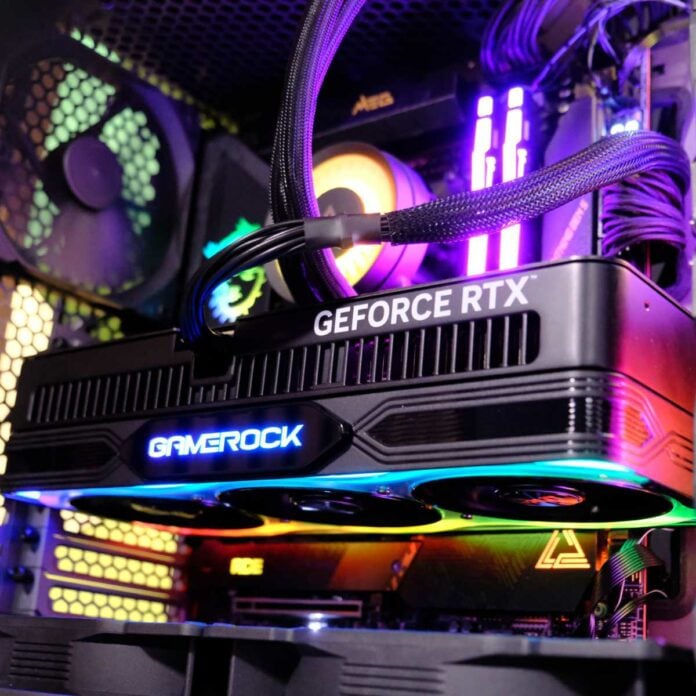Your graphics card is the centrepiece of your gaming PC, so it’s only fitting that it add the right amount of bling even as Blackwell slowly but surely scales down towards the midrange. Giving GeForce RTX 5070 Ti the GameRock treatment, Palit’s latest model is a sight for sore eyes, even if a bit familiar.
Its dazzling looks are somewhat allegorical, mirroring the magic of its Multi Frame Generation (MFG) might, but the question remains whether such performance enhancements are enough to combat the tapering rasterised performance we’ve witnessed from Nvidia thus far. In this writer’s opinion, it all comes down to price.
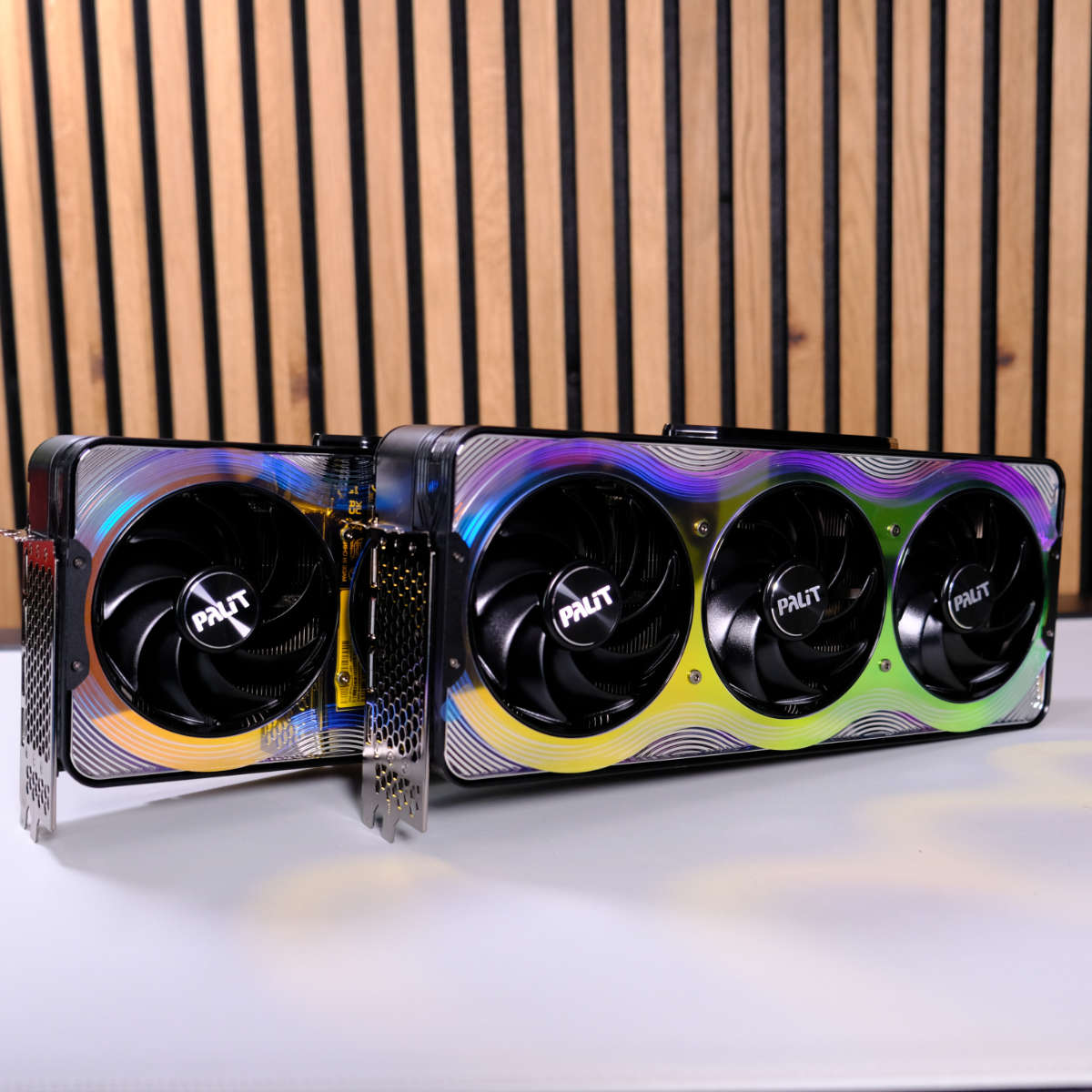

Palit GeForce RTX 5070 Ti GameRock OC
£799
Pros
- DLSS 4 is fantastic
- Exceptionally cool and quiet
- Decent overclock
- GDDR7 memory
- Meaningful Ampere upgrade
Cons
- 16GB of memory sets a lower ceiling
- Incremental rasterised generational uplift
- £70 more expensive
Club386 may earn an affiliate commission when you purchase products through links on our site.
How we test and review products.
Palit expects GeForce RTX 5070 Ti GameRock OC to be more than the GPU’s base MSRP, costing up to £799 for the overclocked model. This is £70 more than Nvidia’s recommendation, which might be a tough sell depending on performance. You also might see it climb higher with stock shortages and vendors adding their own premium. For now, we’re at the whim of the market.
Specifications
With GeForce RTX 5070 Ti bridging the high-end and midrange gap, there’s a lot to compare, so we’re spoiling you with two of our not-so-patent-pending Club386 Tables of Doom™.
| RTX 5070 Ti | RTX 5080 | RTX 5090 | |
|---|---|---|---|
| Released | Feb 2025 | Jan 2025 | Jan 2025 |
| Codename | Blackwell | Blackwell | Blackwell |
| GPU | GB203 | GB203 | GB202 |
| Process | TSMC 4N | TSMC 4N | TSMC 4N |
| Transistors | 45.6bn | 45.6bn | 92.2bn |
| Die size | 378mm² | 378mm² | 750mm² |
| CUDA cores | 8,960 | 10,752 | 21,760 |
| Boost clock | 2,452MHz | 2,617MHz | 2,407MHz |
| FP32 Boost TFLOPS | 43.9 | 56.3 | 104.8 |
| SM count | 70 of 84 | 84 of 84 | 170 of 192 |
| RT cores | 70 (4th Gen) | 84 (4th Gen) | 170 (4th Gen) |
| RT TFLOPS | 133.2 | 170.6 | 317.5 |
| Tensor cores | 280 (5th Gen) | 336 (5th Gen) | 680 (5th Gen) |
| FP16 Acc TFLOPS | 351.5 | 450.2 | 419 |
| ROPS | 96 | 112 | 176 |
| Memory | 16GB | 16GB | 32GB |
| Memory type | GDDR7 | GDDR7 | GDDR7 |
| Mem. clock | 28Gb/s | 30Gb/s | 28Gb/s |
| Mem. interface | 256-bits | 256-bits | 512-bits |
| Mem. bandwidth | 896GB/s | 960GB/s | 1,792GB/s |
| Board power | 300W | 360W | 575W |
| Launch MSRP | $749 | $999 | $1,999 |
Packing a cut-down GB203 die engineered to meet a more attractive price point, GeForce RTX 5070 Ti has much in common with RTX 5080. It keeps six of the seven GPCs (Graphics Processing Clusters) active, while not skimping on the streaming multiprocessor and ray tracing core counts.
Much like its big brother, 16GB of memory is the bare minimum necessary for high-end gaming in 2025, as anything less will start to struggle with the latest games. Still, it feels much more at home on a 70-class card targeting a lower price point. You’ll still benefit from the same improvements, as moving to GDDR7 amplifies bandwidth and it carries the same 28Gb/s speed as the flagship GeForce RTX 5090.
As far as cuts go, nothing raises an eyebrow. Even shying away from MSRP, Palit’s overclocked model costs 27% less than its GeForce RTX 5080 equivalent, shaping up exactly as I expected. Plus, there’s still plenty of room on the top-end GB202 die for Nvidia to wiggle in an RTX 5080 Ti in the same vein.
| RTX 5070 Ti | RTX 4070 Ti Super | RTX 3070 Ti | |
|---|---|---|---|
| Released | Feb 2025 | Jan 2024 | Jun 2021 |
| Codename | Blackwell | Ada Lovelace | Ampere |
| GPU | GB203 | AD103 | GA104 |
| Process | TSMC 4N | TSMC 4N | Samsung 8nm |
| Transistors | 45.6bn | 45.9bn | 17.4bn |
| Die size | 378mm² | 378.6mm² | 392.5mm² |
| CUDA cores | 8,960 | 8,448 | 6,144 |
| Base clock | 2,300MHz | 2,340MHz | 1,580MHz |
| Boost clock | 2,452MHz | 2,610MHz | 1,770MHz |
| FP32 Boost TFLOPS | 43.9 | 44.1 | 21.75 |
| SM count | 70 | 66 | 48 |
| RT cores | 70 (4th Gen) | 66 | 48 |
| RT TFLOPS | 133.2 | 102 | – |
| Tensor cores | 280 (5th Gen) | 264 | 192 |
| FP16 Acc TFLOPS | 351.5 | 103.0 | 21.75 |
| ROPS | 96 | 96 | 96 |
| Memory | 16GB | 16GB | 8GB |
| Memory type | GDDR7 | GDDR6X | GDDR6X |
| Mem. clock | 28Gb/s | 21Gb/s | 19Gb/s |
| Mem. interface | 256-bits | 256-bits | 256-bits |
| Mem. bandwidth | 896GB/s | 672GB/s | 608GB/s |
| Board power | 300W | 285W | 290W |
| Launch MSRP | $749 | $799 | $599 |
Much like GPUs present, there are no major generational shocks as we turn to the graphics cards it replaces. Sticking with the same TSMC 4N fabrication process results in expected clock speeds, but the beauty of Blackwell is its scalability. Palit’s top operating frequencies reach a lofty 2,902MHz, eclipsing Nvidia’s rating by 18%.
Intertwined with an emphasis on newer, better architecture in the form of 4th Gen RT Cores, 5th Gen Tensor Cores, and fast GDDR7 memory, it’s in a winning combination.
Following in the footsteps of GeForce RTX 4070 Ti, there’s no Founders Edition this time around, leaving the ball firmly in the court of add-in-board partners. Palit’s GameRock line isn’t the only one to breeze past the £729 MSRP, but it does run the risk of pushing people towards RTX 5080. Fortunately, I’d argue it does go some way to justifying the added premium.
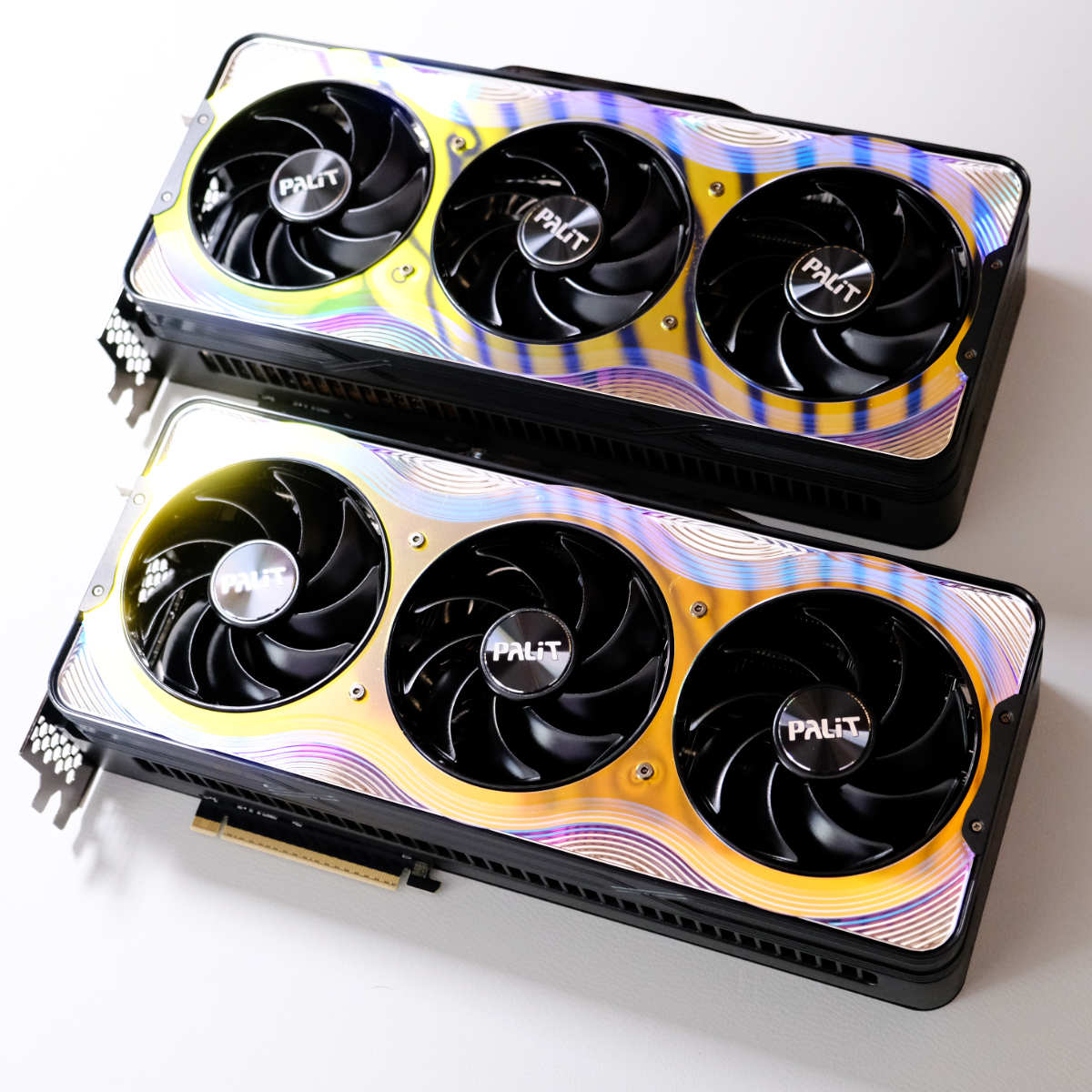
Design
When I first unboxed Palit GeForce RTX 5070 Ti GameRock, I almost did a cartoon blink and rubbed my eyes because I was seeing double. Taking an identical approach to Palit GeForce RTX 5080 GameRock, it features the same packaging, accessories, and instantly recognisable faceplate. Short of an identifying sticker on the rear, they could’ve very easily been the twin stars of a Parent Trap reboot.
Of course, this is part and parcel for any series of graphics card, as no brand wants to sink additional overhead into unique designs for every model Nvidia releases. It’s also no criticism, although it does mean you’ll contend with a 3.5-slot titan that dwarfs even the 3.1-slot Palit GeForce RTX 4070 Ti Super JetStream.
Measuring 331.9mm x 150mm x 70.4mm just means there’s more of its gorgeous iridescent curves to love, which goes a long way to plugging the gap left by a lack of Founders Edition. Plus, it sure comes in handy when we start talking about thermals and sound profile.
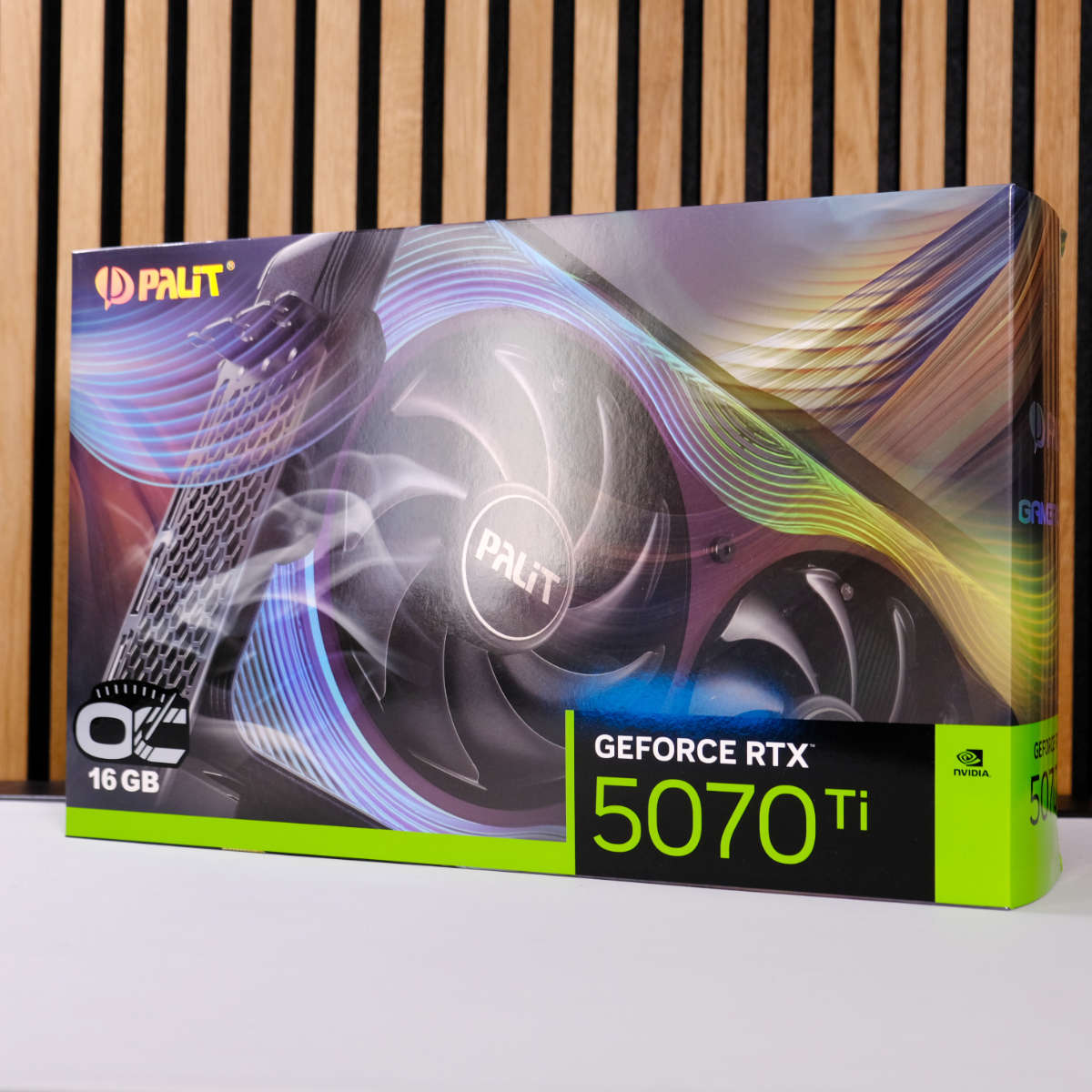
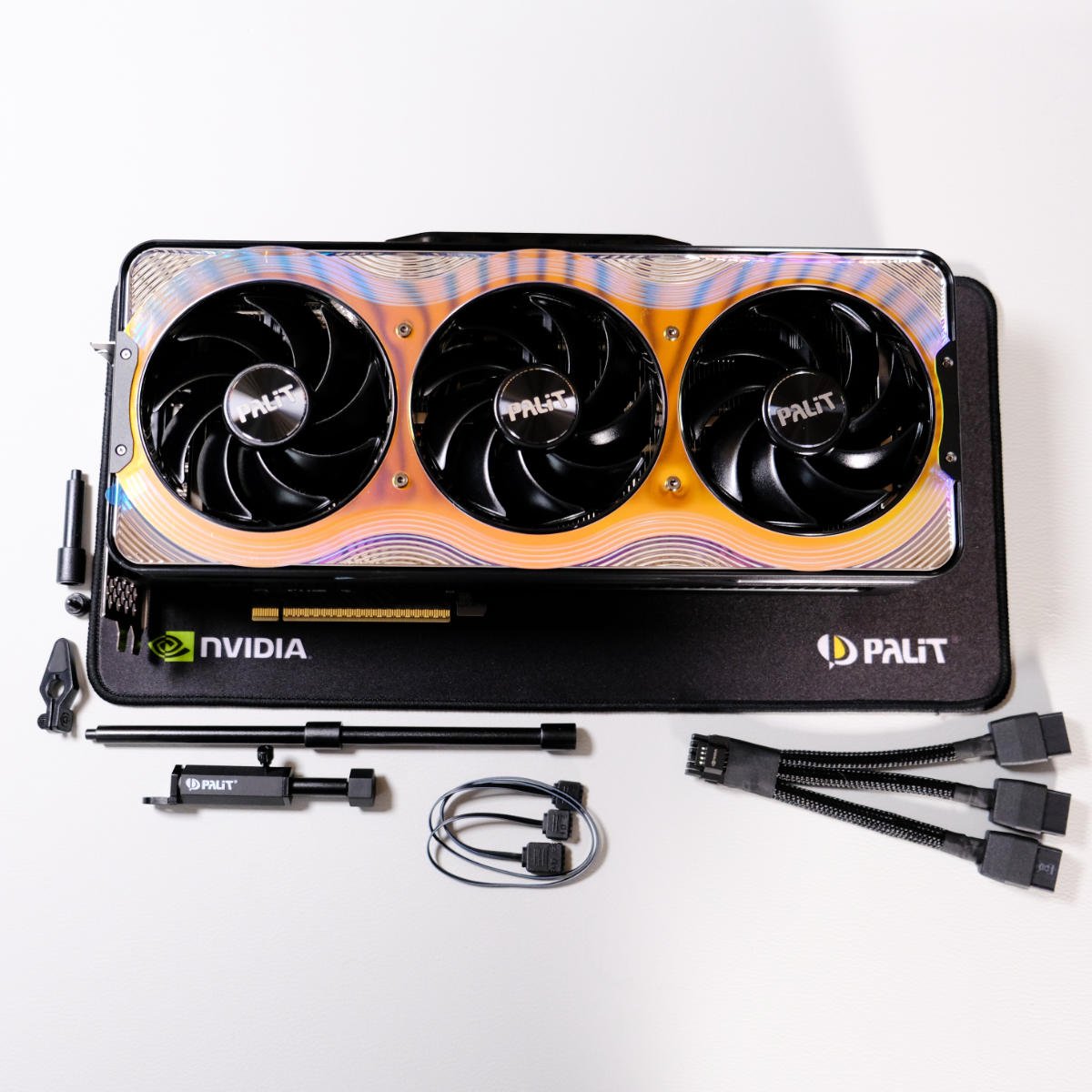
Beneath the bold design lies function to complement form, encasing a trio of nine-bladed fans. As much as I believe white would’ve been a better choice to reflect the gorgeous RGB this card is capable of, particularly when using the ARGB cable to sync it to your motherboard, its glossy black approach threads everything together in a neat bow.
Sporting a more refined look, Palit has swapped its 2000s-era GameRock logo of old for something more mature. It’s a smart decision, since it’ll be glowing at you from behind tempered glass for years to come, and this helps make it a bit more timeless.
The block white GeForce logo lets the side down a touch, particularly as the font is bigger than Palit’s own. Previous graphics cards in the GameRock range lit this up in tandem with all its other RGB elements to soften the branding overload, but that’s no longer the case for Blackwell models. Instead, you’ll just have to find solace in the intricate grooves hugging the bezel and brushed metal backplate, which certainly class it up.
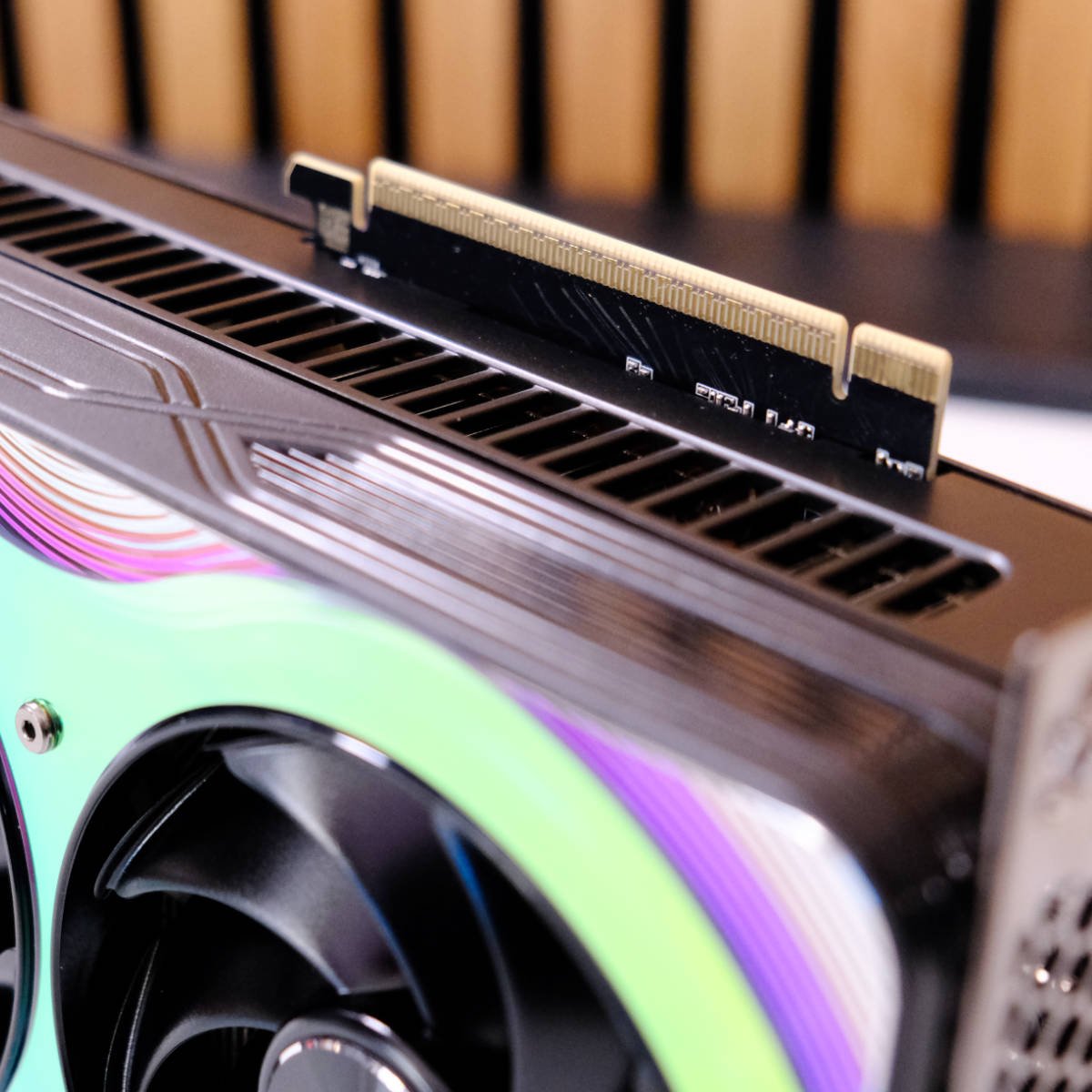
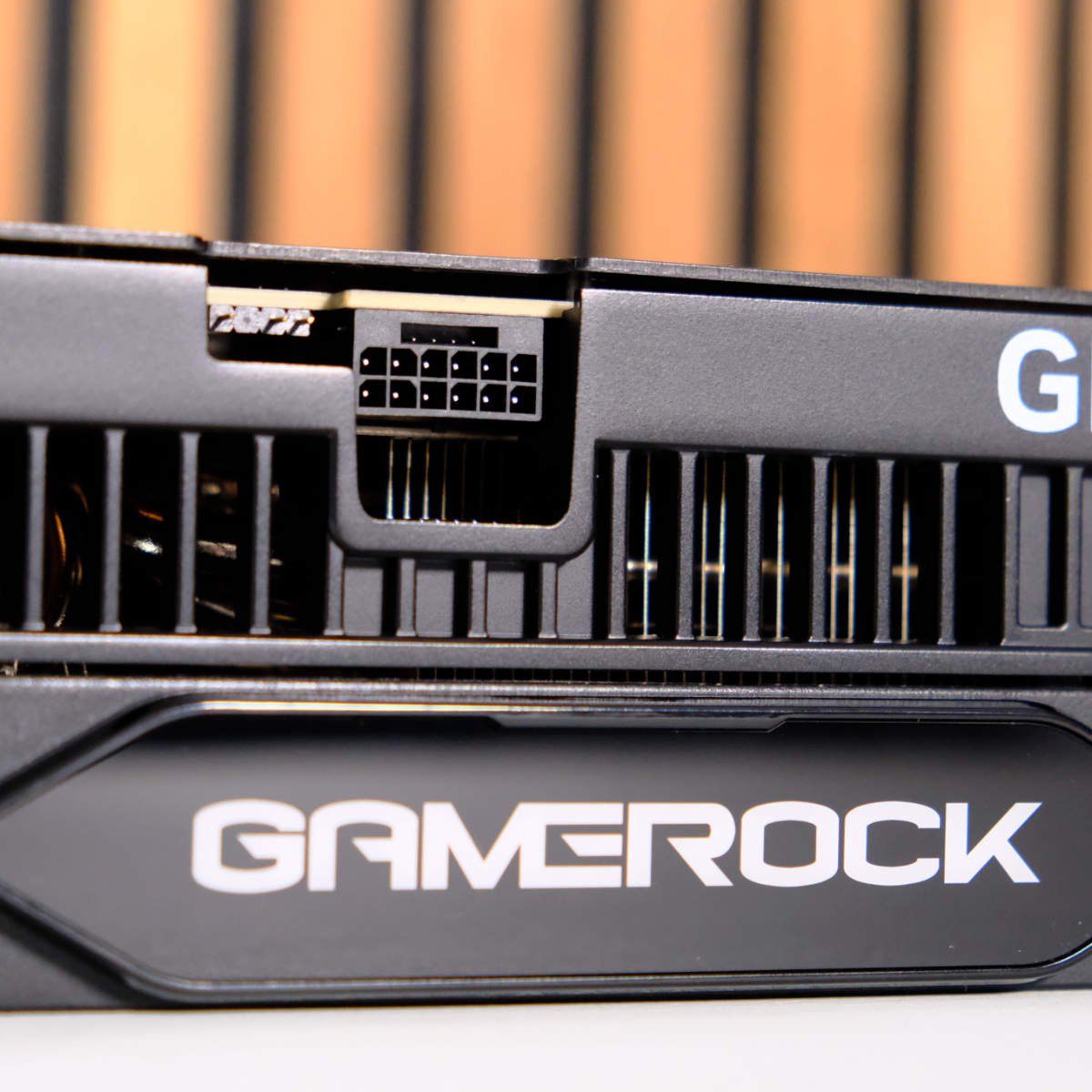
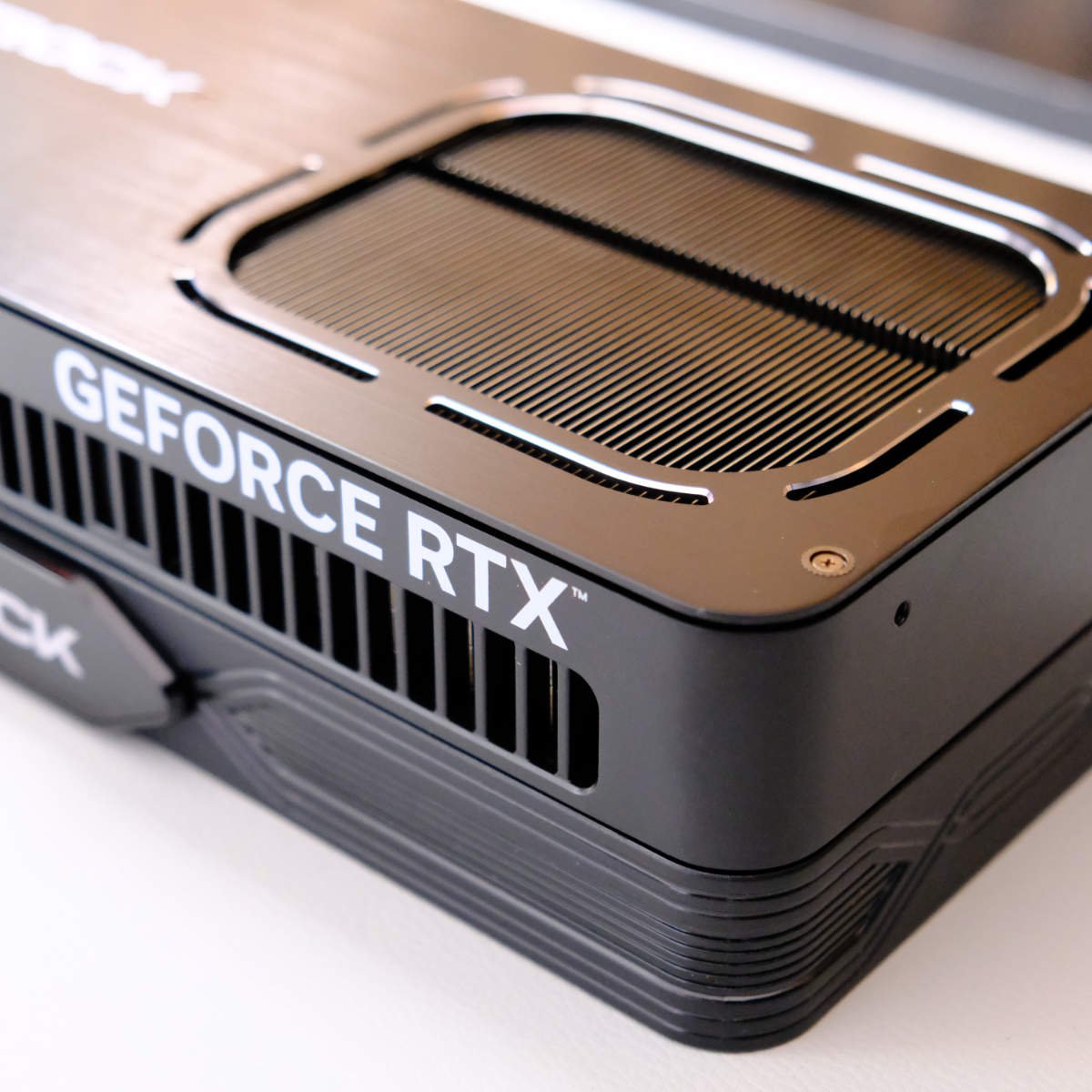
For better or worse, the 12V-2×6 power connector is back again, offering up to 600W through a single cable. Despite a few revisions by shortening pins by 0.1mm and lengenthing terminals by 0.15mm, we’ve still spotted reports of power distribution and melting issues that plagued the original 12VHPWR specification. Investigations are ongoing, however, and Palit offers a three-year warranty just in case.
Although a 12V-2×6 or 12VHPWR-supported power supply is a bonus for cable management, you don’t need to upgrade in order to run Nvidia’s latest and greatest cards. Palit supplies an eight-pin splitter, which works with just fine with all modern PSUs without a hitch. It’s curious to see the same three-way splitter as the comparatively hungrier RTX 5080 since our 70-class card can get away with a dual adapter just fine, but there’s comfort in parity.
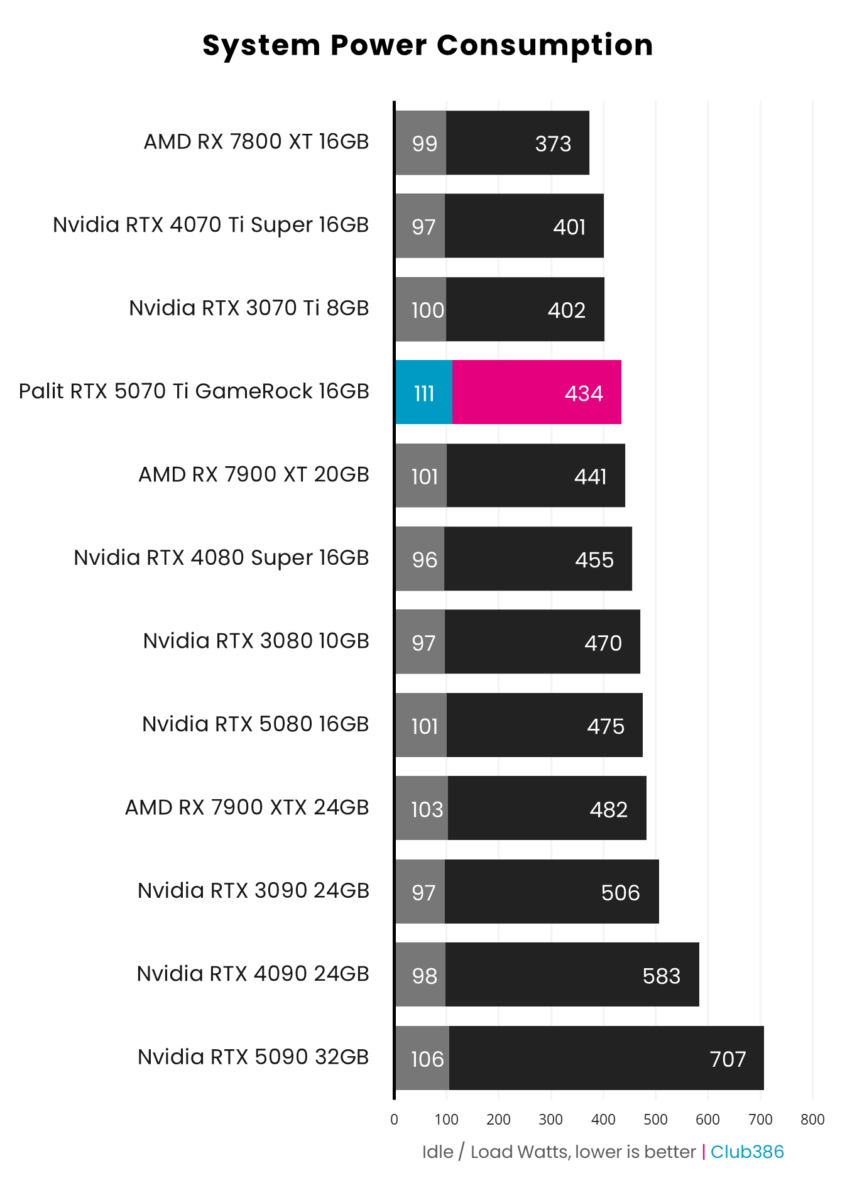
Nvidia advises you pair RTX 5070 Ti with a 750W power supply, as the graphics card alone is rated up to 300W. It pays to be careful, but much like the rest of Blackwell, that leaves ample headroom on the table as Palit draws just 434W from the plug under load and 111W when idle. This might climb higher with RGB strips and extra add-in cards, should you find the room, but you won’t run short.
A lower power draw combines nicely with the bulky cooler to keep peak temperatures at just 58°C, the lowest we’ve seen from Blackwell yet. This also doesn’t come at the expense of noise, which sits at a barely-audible 33.7dBA. Only in absolute silence could I hear the fans speed up from its 0rpm mode to an average of 1,150rpm, which is as stealthy as they come.
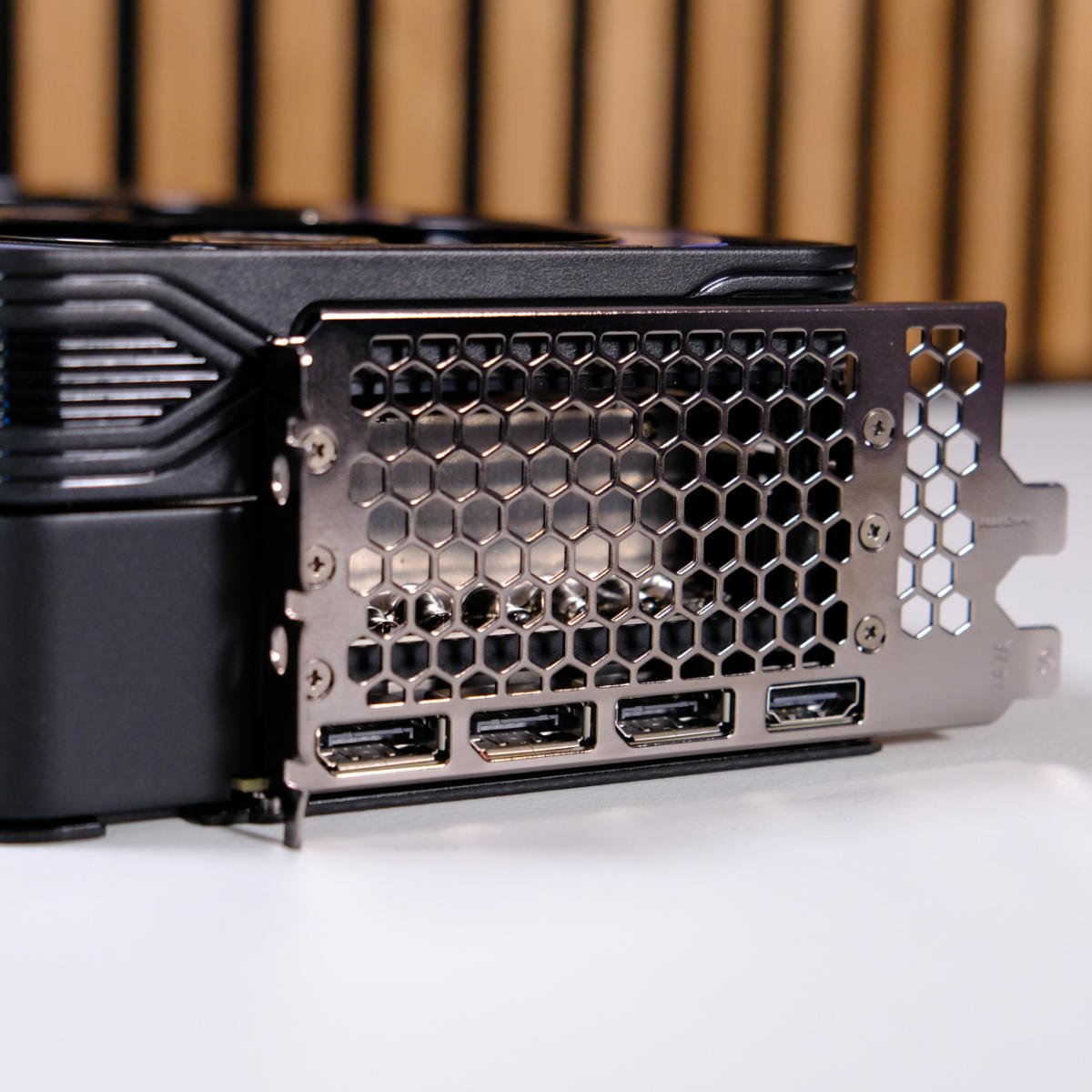
All RTX 50 Series models come equipped with the latest display outputs, including three DisplayPort 2.1b and one HDMI 2.1b. These ports offer ample bandwidth to support 4K 12-bit HDR at 480Hz or 8K 12-bit HDR at 165Hz with display stream compression (DSC). While the RTX 5070 Ti may not fully utilise these peak capabilities, it’s always better to have the option than to find yourself needing it later.
Performance
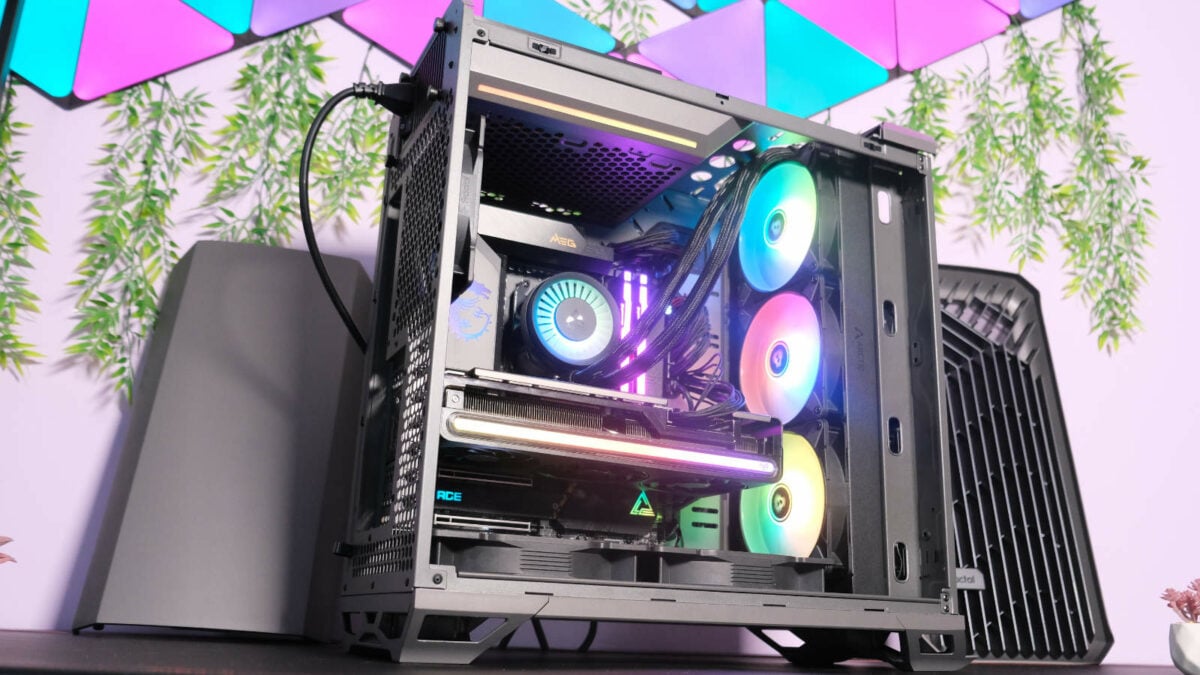
Our 7950X3D Test PCs
Club386 carefully chooses each component in a test bench to best suit the review at hand. When you view our benchmarks, you’re not just getting an opinion, but the results of rigorous testing carried out using hardware we trust.
Shop Club386 test platform components:
CPU: AMD Ryzen 9 7950X3D
Motherboard: MSI MEG X670E ACE
Cooler: Arctic Liquid Freezer III 420 A-RGB
Memory: 64GB Kingston Fury Beast DDR5
Storage: 2TB WD_Black SN850X NVMe SSD
PSU: be quiet! Dark Power Pro 13 1,300W
Chassis: Fractal Design Torrent Grey
It’s only right that Palit GeForce RTX 5070 Ti GameRock gets the same initiation as all cards before it. Housed in the Club386 test bench, we’ve paired it with an assortment of top-tier hardware led by AMD Ryzen 9 7950X3D and pitted it against our usual suite of benchmarks.
Application & AI
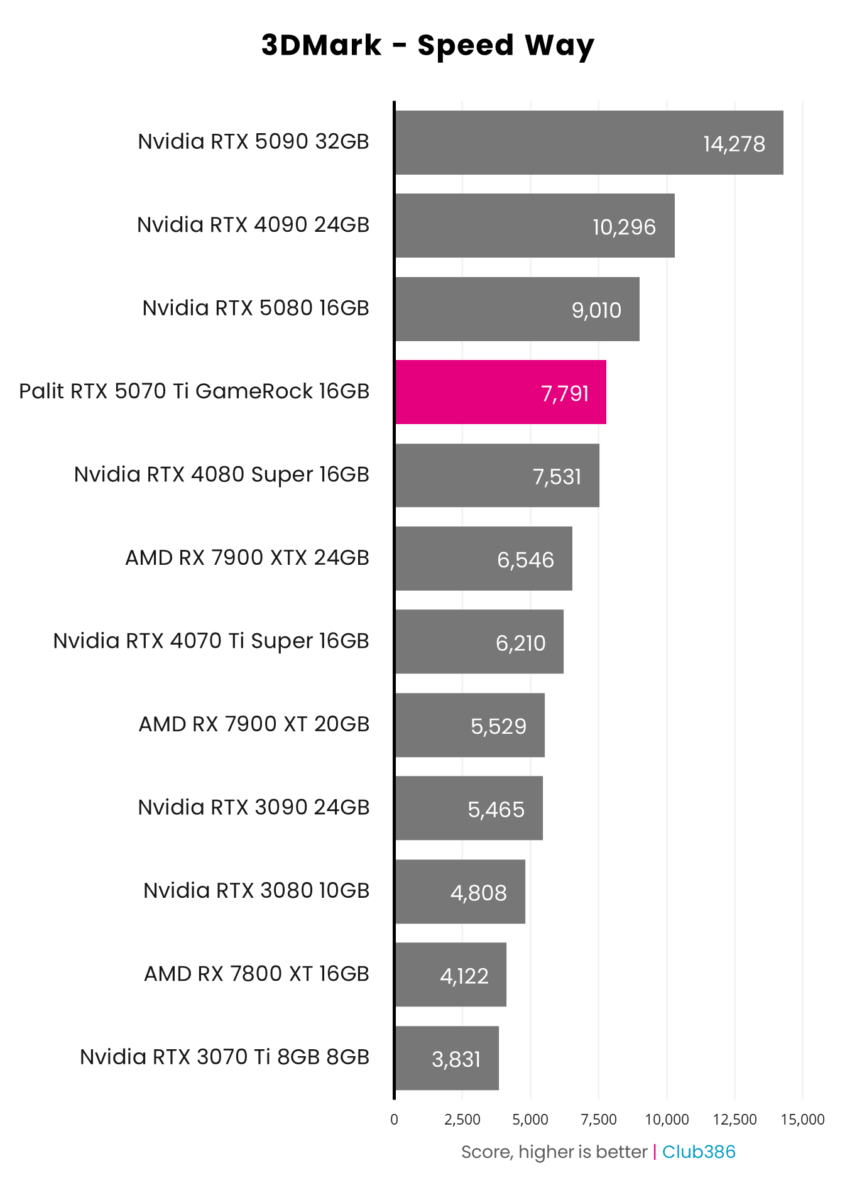
Right out of the gate, Palit GeForce RTX 5070 ti GameRock outperforms its Super predecessor by 25% in 3DMark Speed Way tests, flexing its ray tracing muscles. Perhaps not surprising given it features more ray tracing cores, but it’s not all about quantity. Our latest Blackwell is actually ten short of RTX 4080 Super, yet manages to push past on generational improvements alone.
Considering the sheer difference in specs, keeping within 14% of its 80-class sibling is impressive, particularly with a 27% price gap. Bravo.
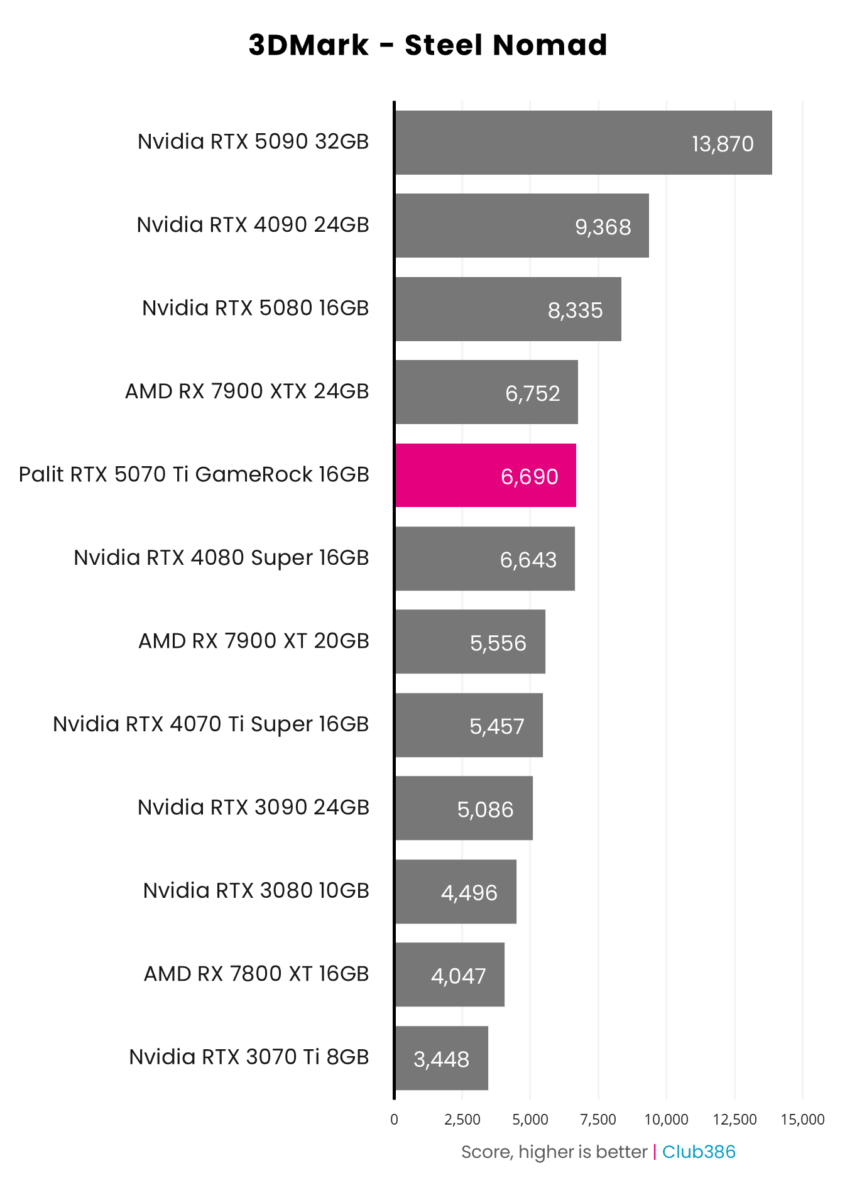
AMD’s rasterised powerhouse get a bit of a reprieve in 3DMark Steel Nomad tests, as Radeon RX 7900 XTX slips past our newcomer. Thankfully, RTX 5070 Ti maintains its lead over both its predecessors, boasting a 23% generational leap.
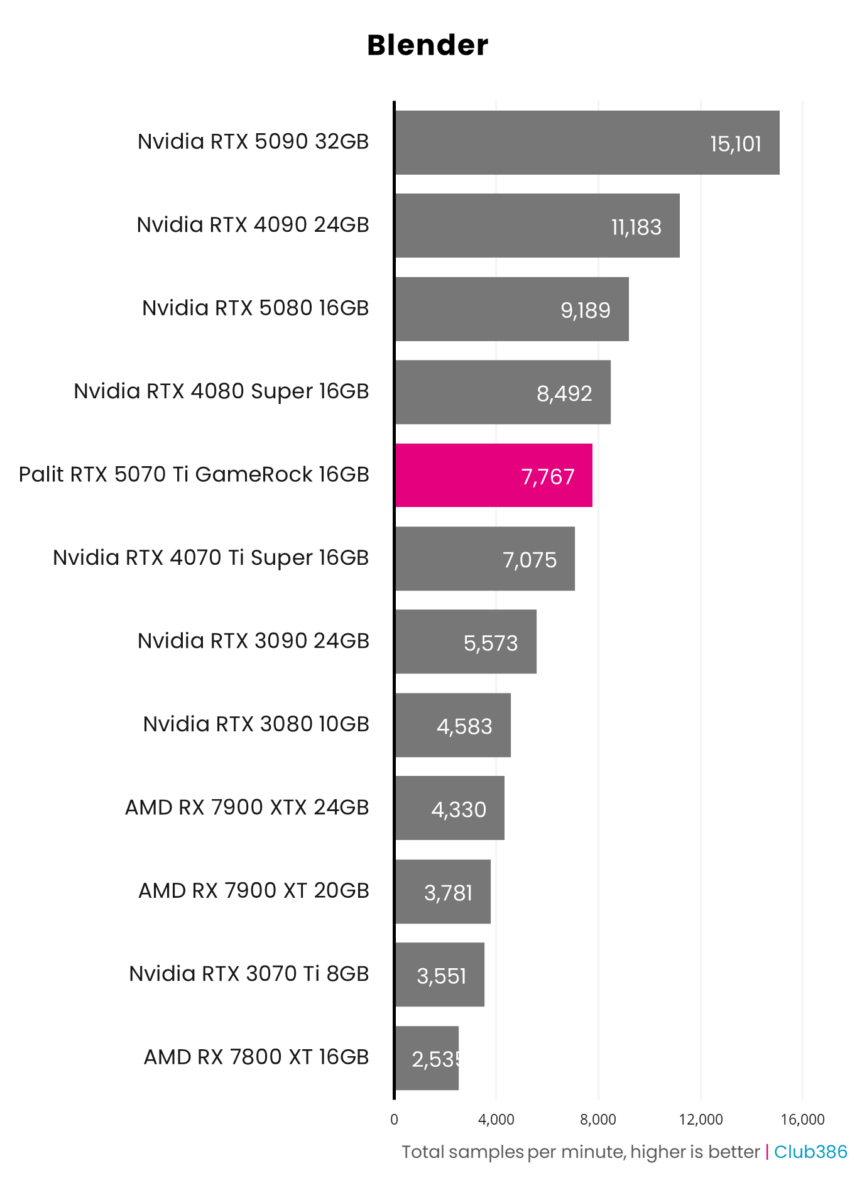
RTX 4080 Super regains compsure in Blender, leaving RTX 5070 Ti stuck between the two Supers like one of its MFG frames. Still, 7,767 samples per minute is nothing to scoff at, affording it a 10% gen-on-gen performance increase.
You’re better looking at this from Ampere’s perspective. Upgrading from RTX 30 Series will net you a 39% boost over the flagship, and more than double its previous-previous gen equivalent.
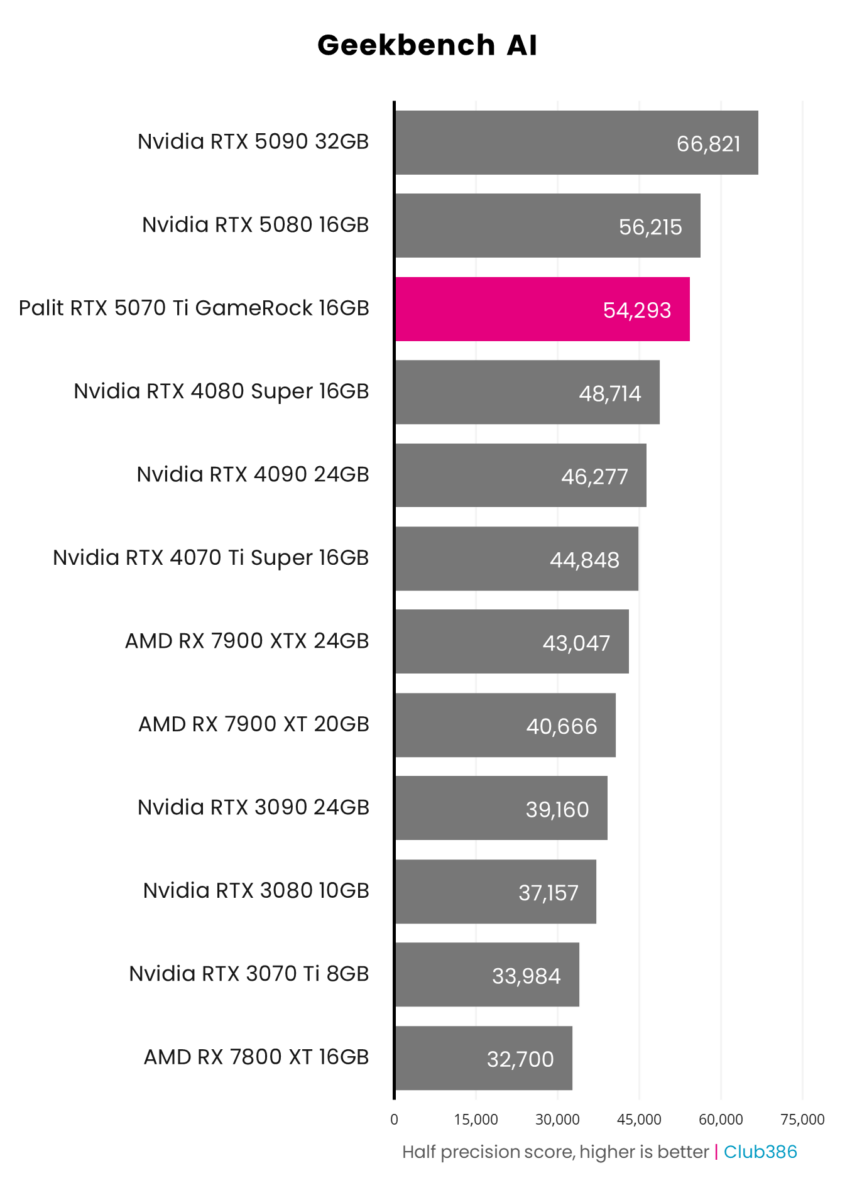
Steering the course for Blackwell, artificial intelligence is a major strength for RTX 5070 Ti. The only models standing up to it in Geekbench AI are its direct siblings, as both AMD and Nvidia’s past generations start to flag.
Similar to its ray tracing strength, we can attribute its fantastic 54,293 half precision score to newly minted 5th Generation Tensor Cores, which keeps even RTX 4080 Super at bay.
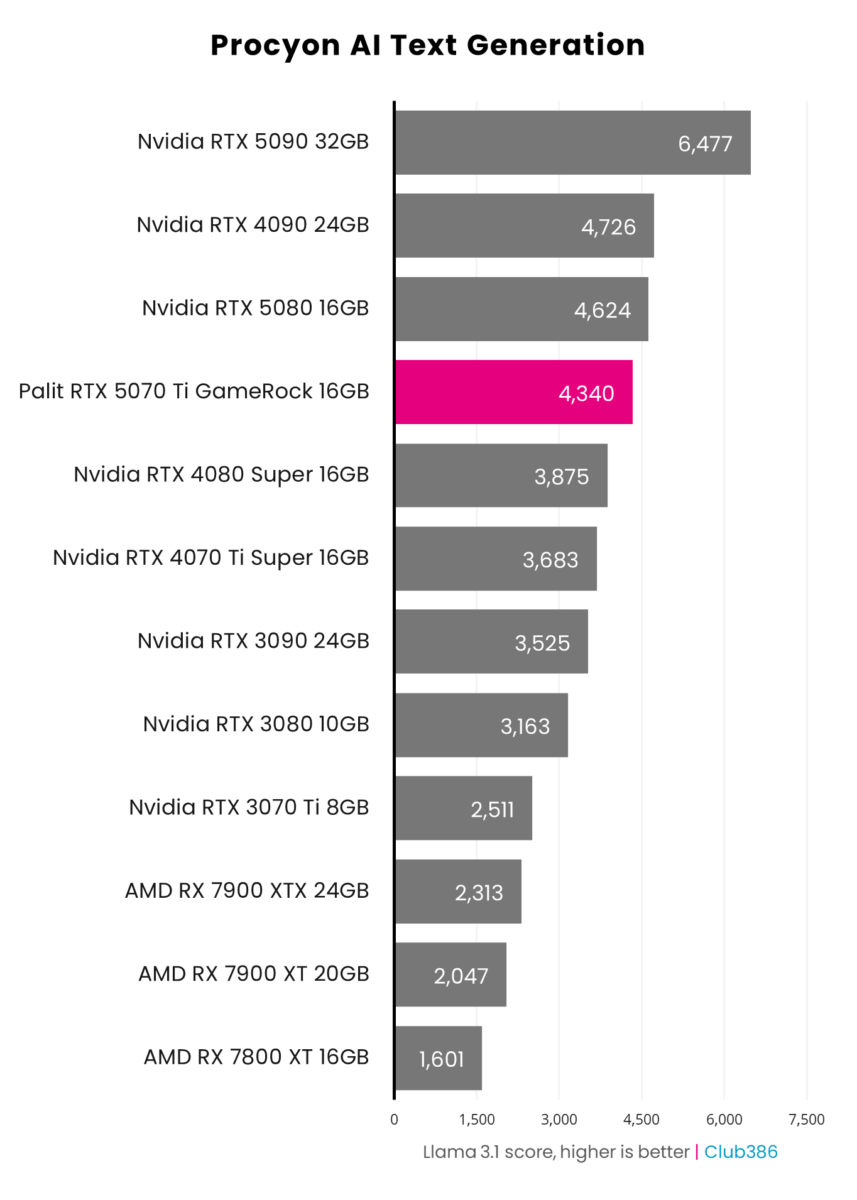
Getting back in the race, RTX 4090 proves it’s nothing to be trifled with when it comes to large language models (LLMs). Still, even without a podium placement, Palit GeForce RTX 5070 Ti GameRock scores an admirable 4,340, stretching to an 18% lead over the previous generation.
Game Rasterisation
So far, synthetic benchmarks reward the graphics card with two thumbs up, but it’s important to see how all this translates into gaming. To see where the midranger sits compared to its rivals, we’ve chosen a selection of triple A titles and used the most popular 1920×1080 (FHD), 2560×1440 (QHD) and 3840×2160 (UHD) resolutions.
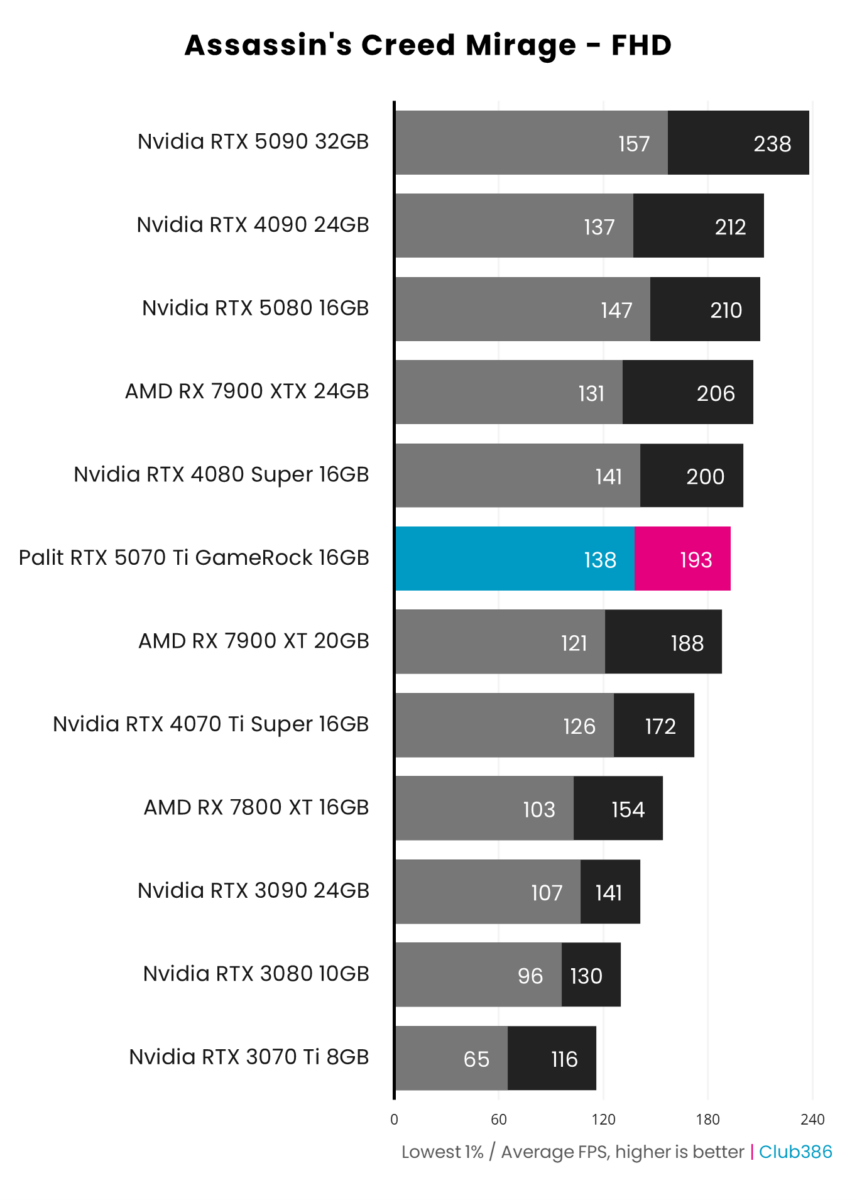
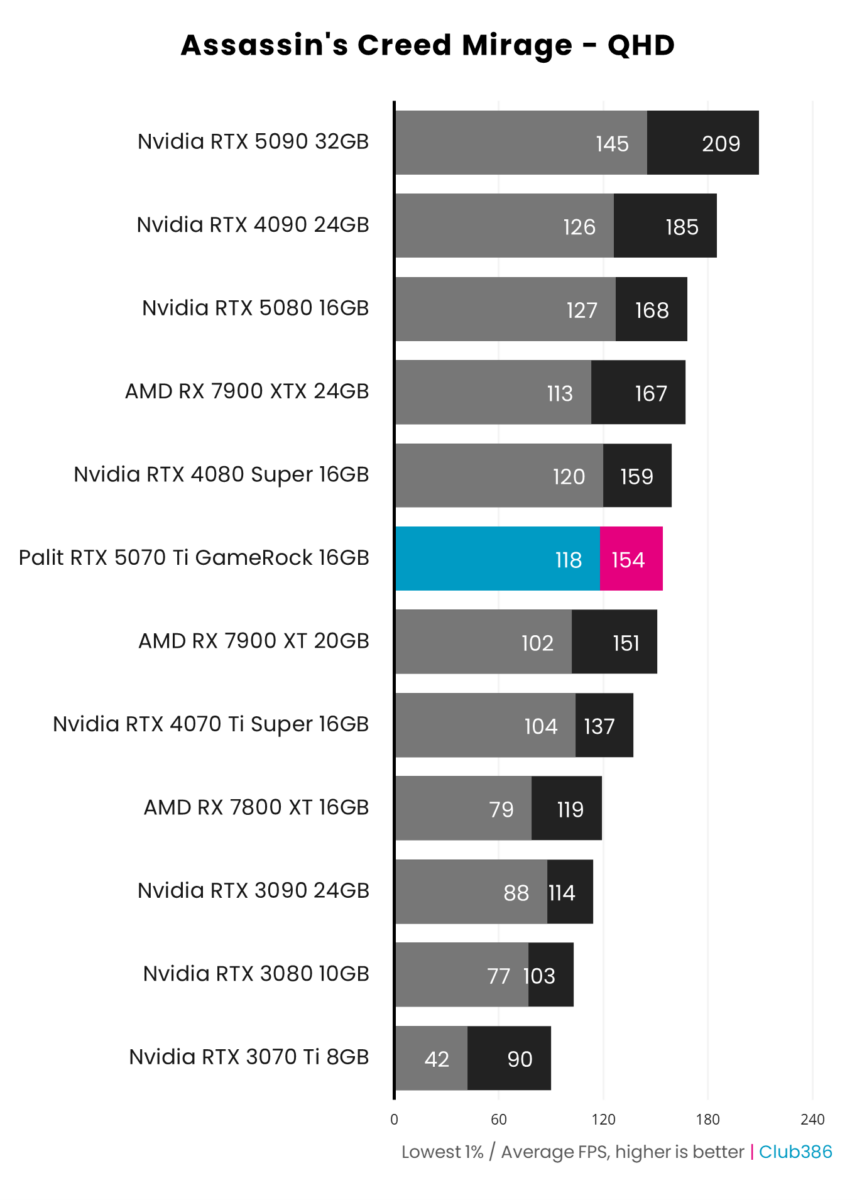
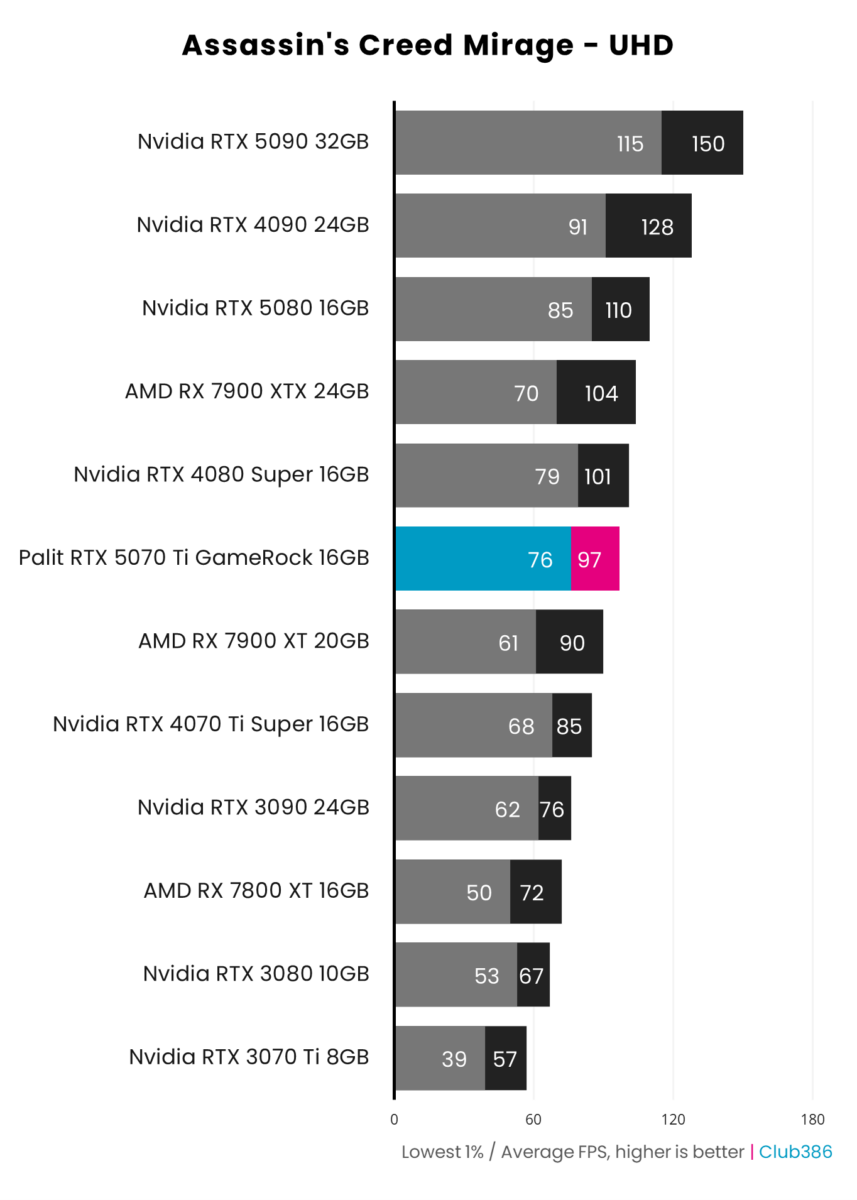
Yet again, Palit GeForce RTX 5070 Ti GameRock is in RTX 4080 Super’s tailwind, narrowing the gap to just 4fps at UHD. Meanwhile, it declares victory against its predecessor by up to 14%.
The graphics card has ample UHD chops, but it’s a top contender in the QHD space, saturating 144Hz monitors when RTX 4070 Ti Super can’t. AMD Radeon RX 7900 XTX does throw a spanner in the works with its current £840 price tag just a stone’s throw away, but this is a game that Team Red tends to excel in. It’ll be interesting to see how the impending Radeon RX 9070 XT plays against 5070 Ti in due time.
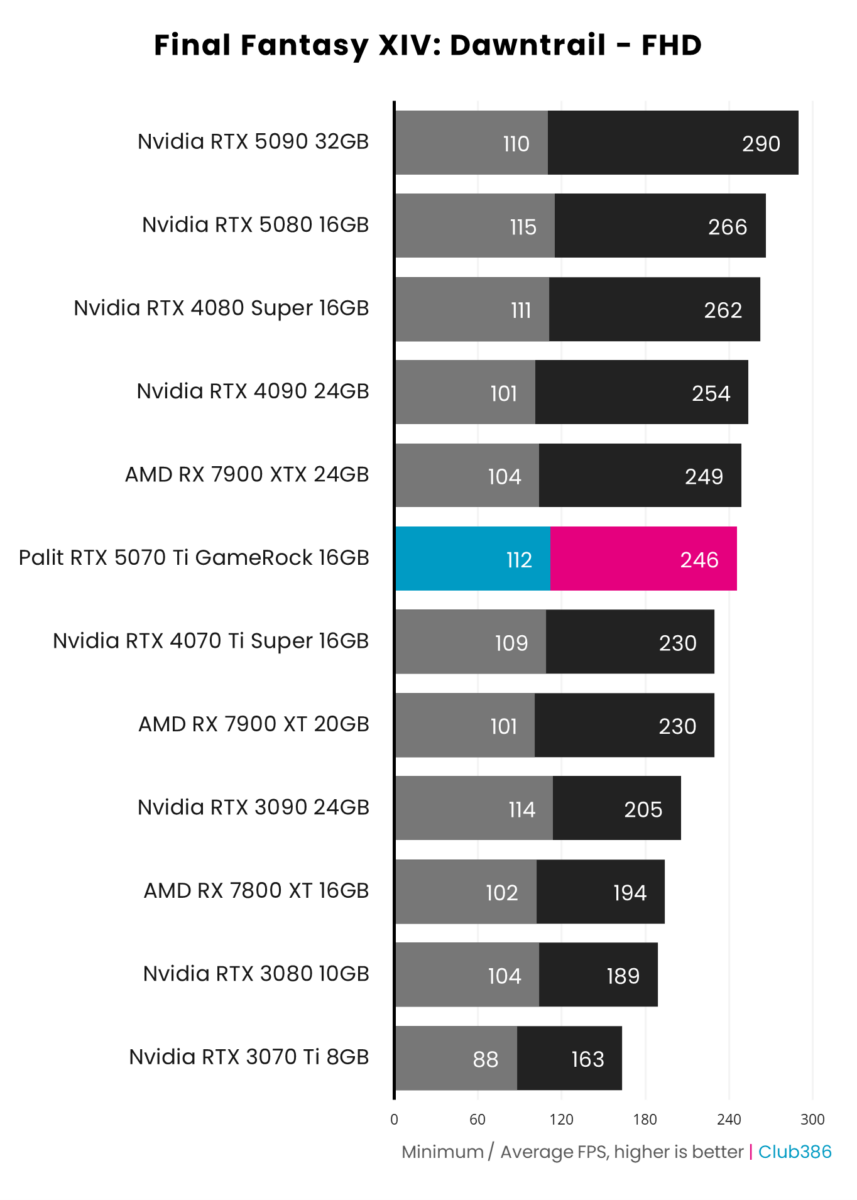
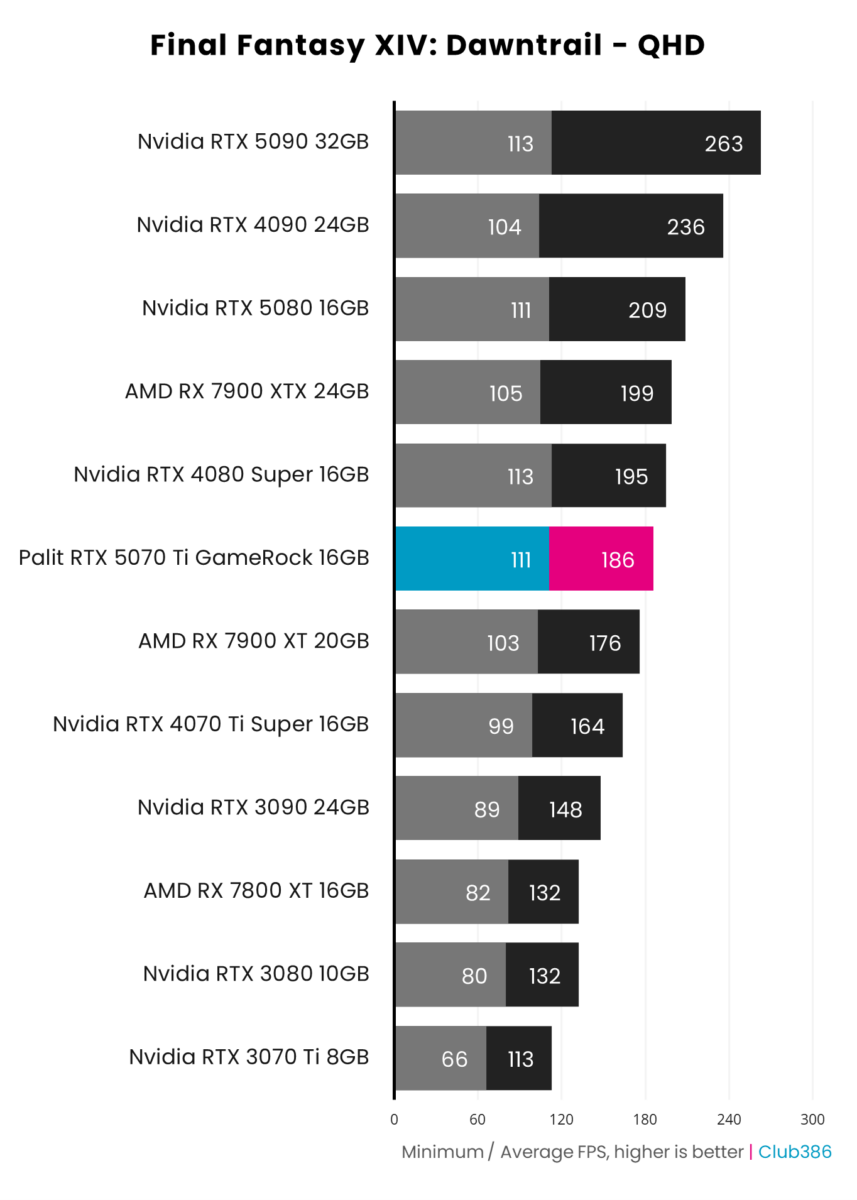
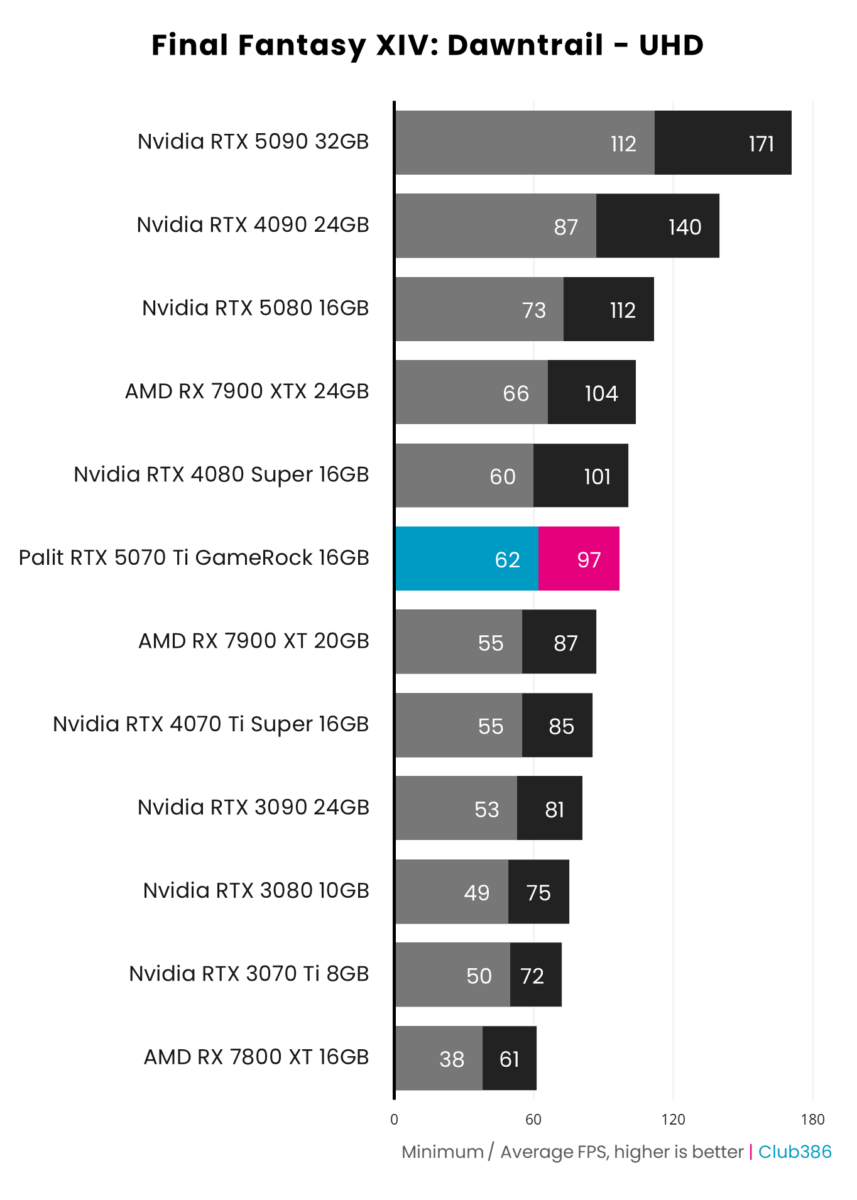
In a bout of deja vu, GeForce RTX 5070 Ti doesn’t slow down in Final Fantasy XIV: Dawntrail, once again just 4fps away from RTX 4080 Super and 14% improved over RTX 4070 Ti Super at UHD. Just shy of triple-figure frame rates, you’re in for a smooth ride across Tural.
Considering the 10% price hike for Palit’s overclocked model, you get just 2fps more than MSRP variants in Square Enix’s MMORPG, which doesn’t paint the most flattering picture. Then again, you get what you pay for and the best performance always comes at a cost.
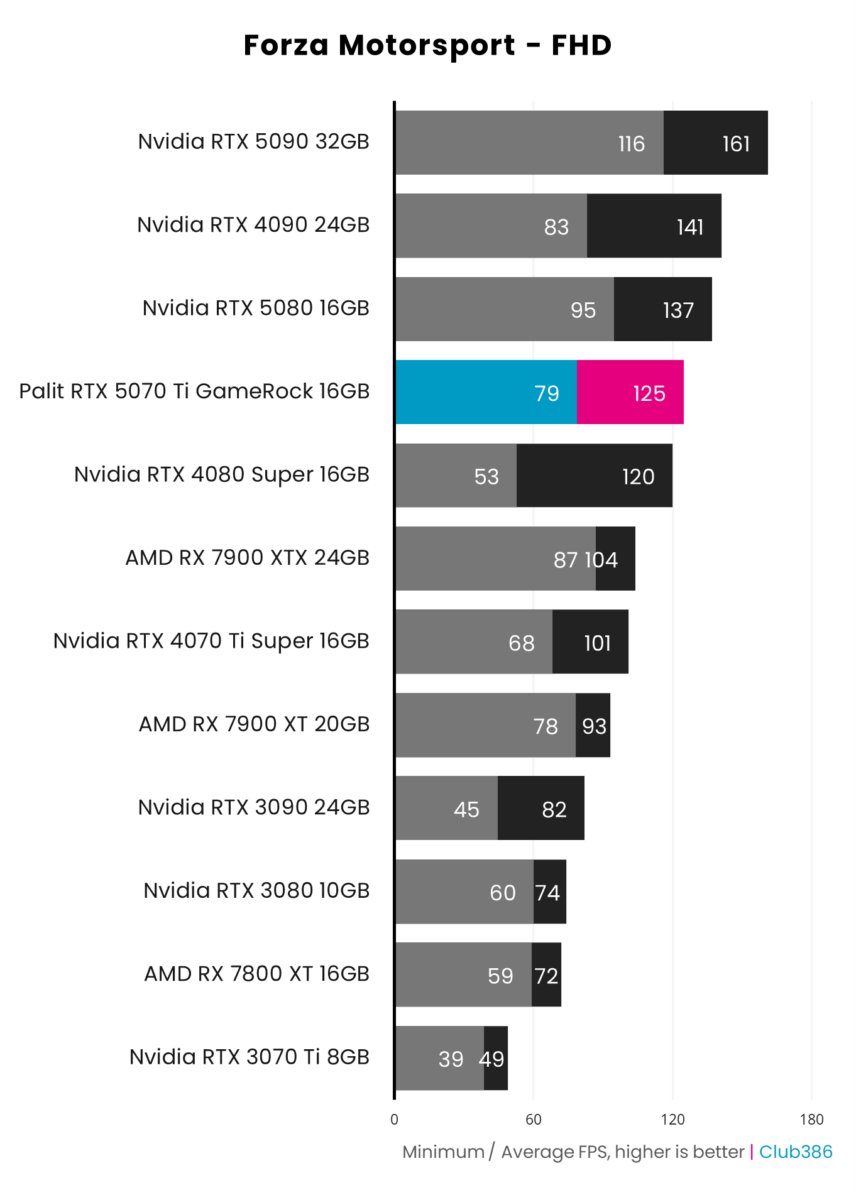
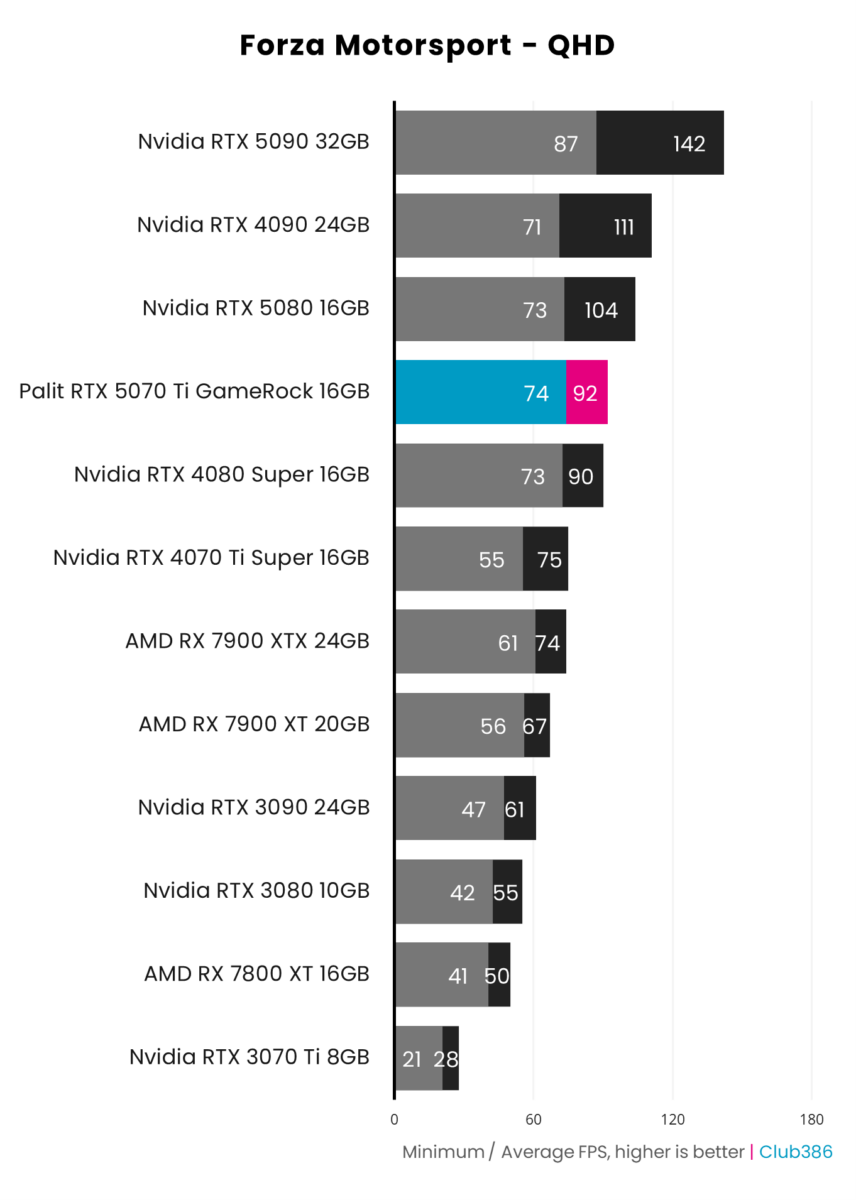
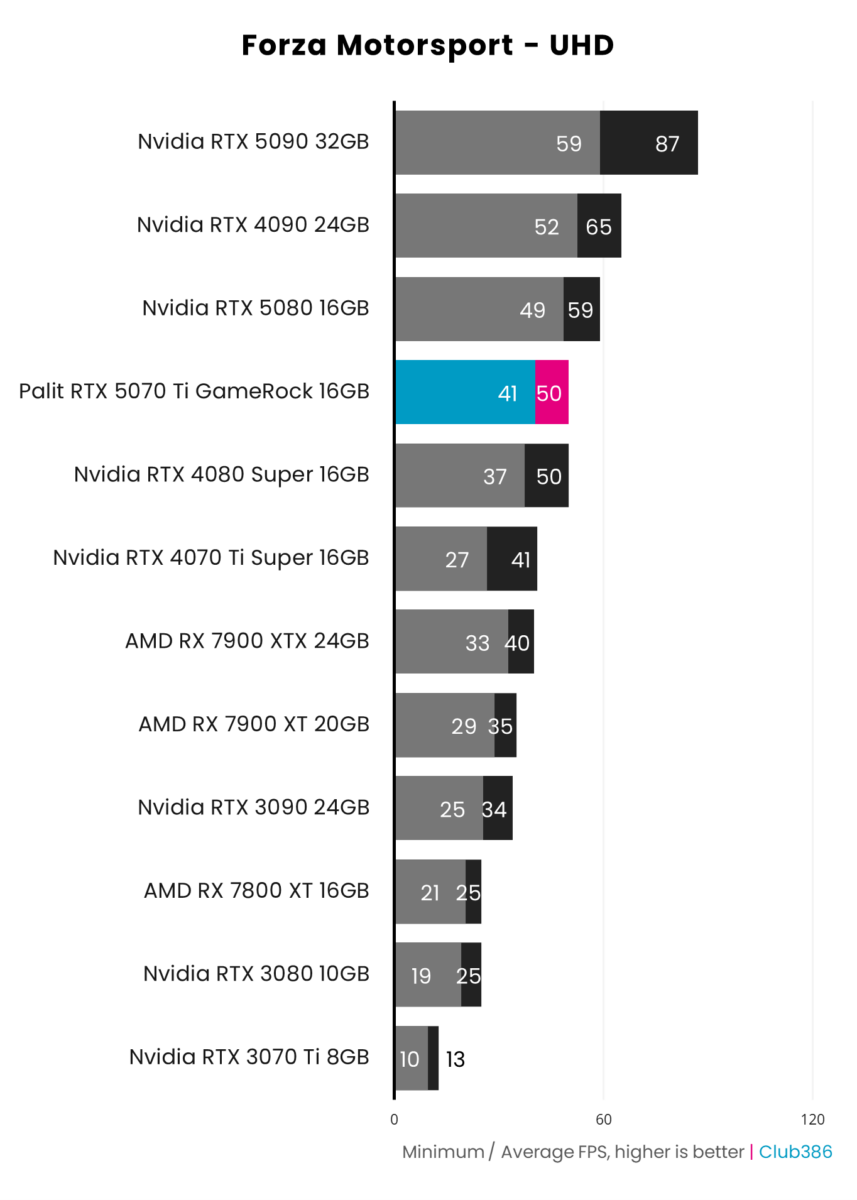
If you’re not a 90-class card, you can be sure you’ll see performance waver when running the ever-demanding Forza Motorsport at UHD. Marcifully, Palit GeForce RTX 5070 Ti holds its own at lower resolutions, beating out RTX 4080 Super for fourth place. 92fps at QHD should see your car speeding around the tarmac in all its glory.
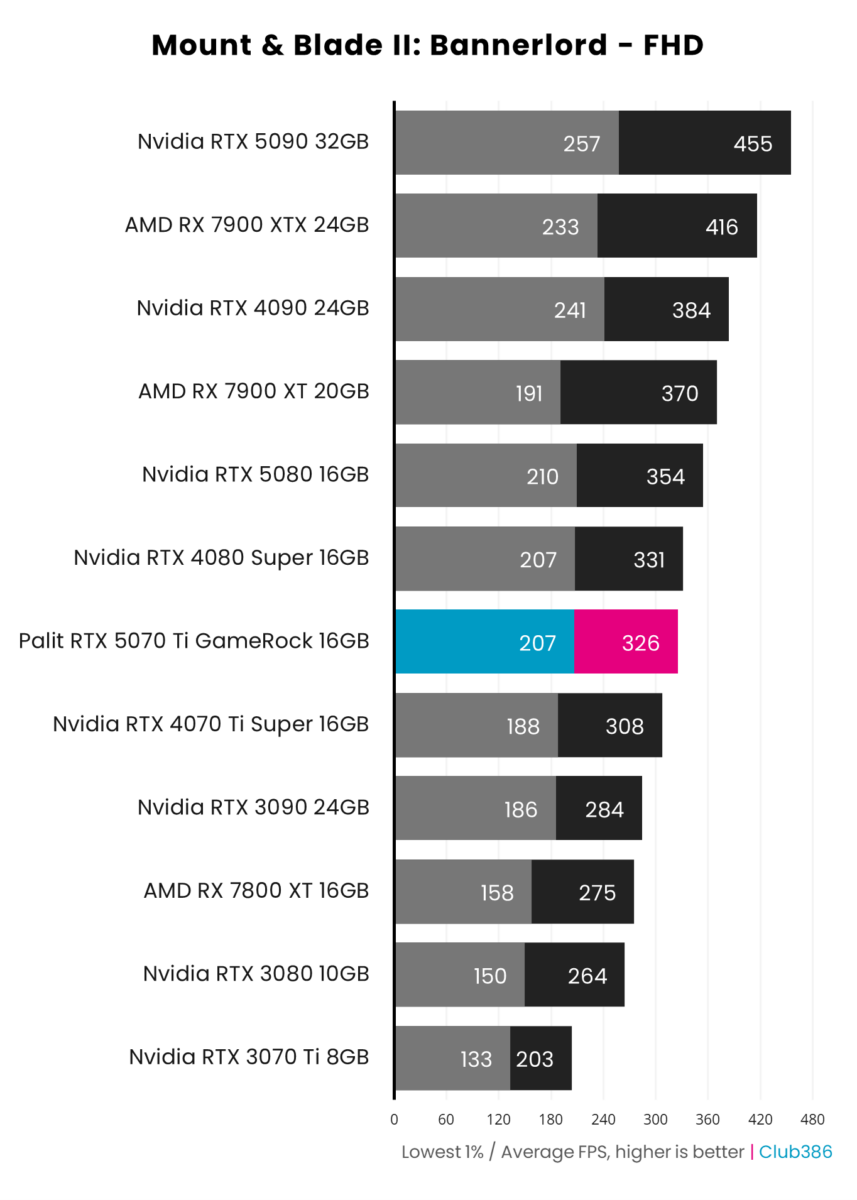
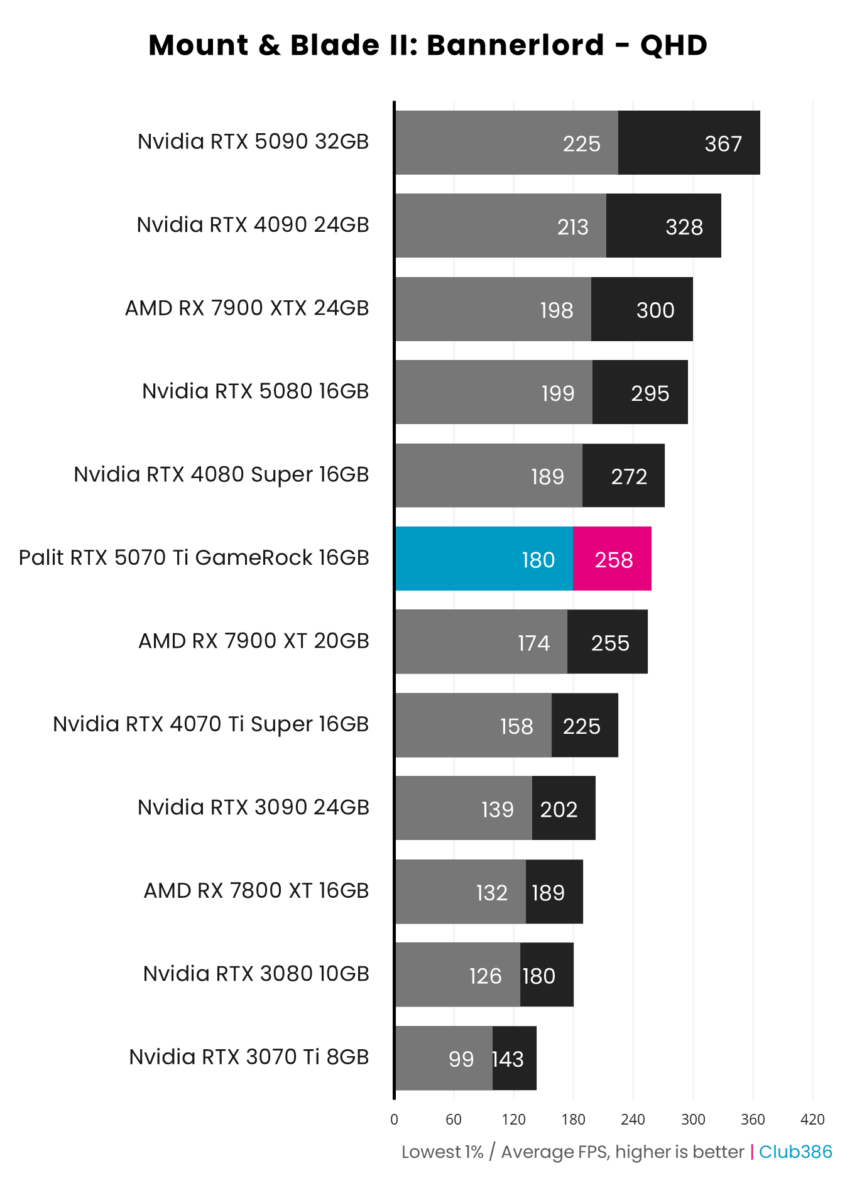
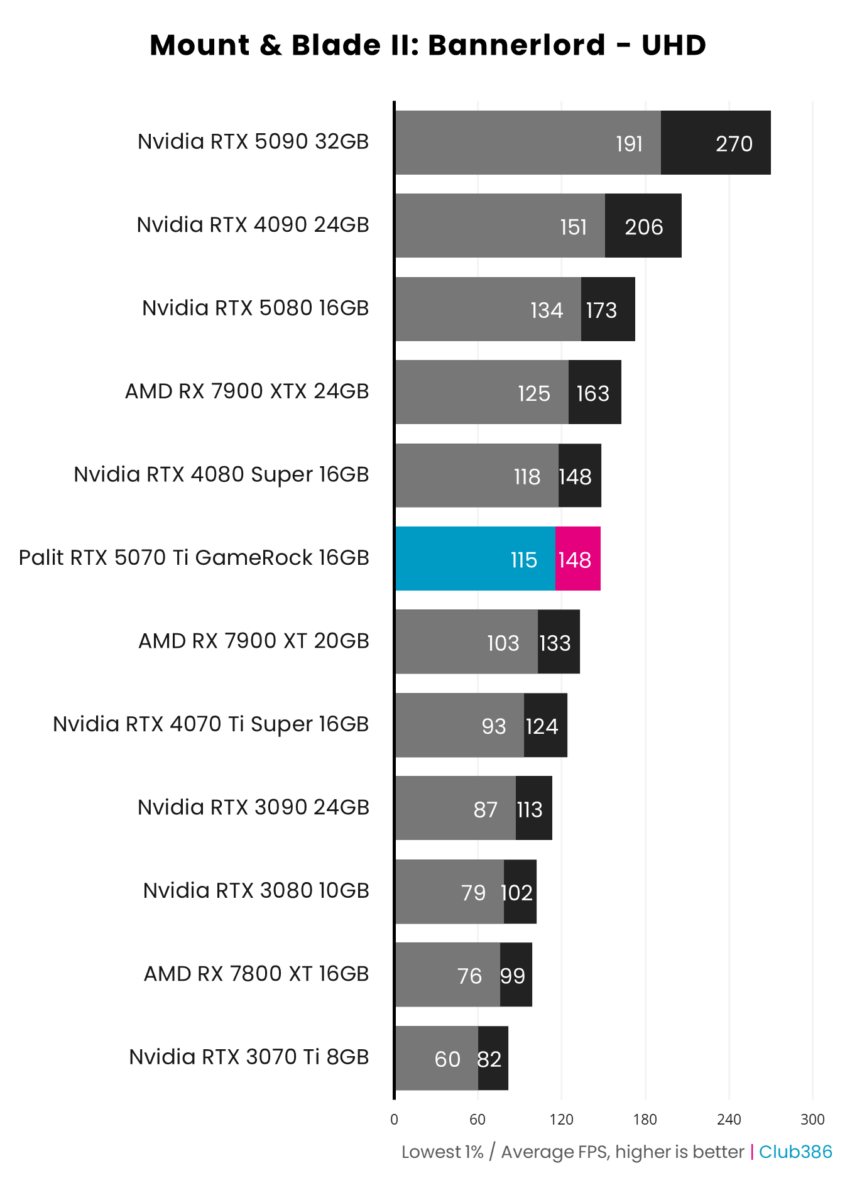
Snug between the two Supers in Mount & Blade II: Bannerlord, Palit’s RTX 5070 Ti shows a more comfortable 19% jump from its forebear, eye-level with the superior 4080 Super 148fps at UHD.
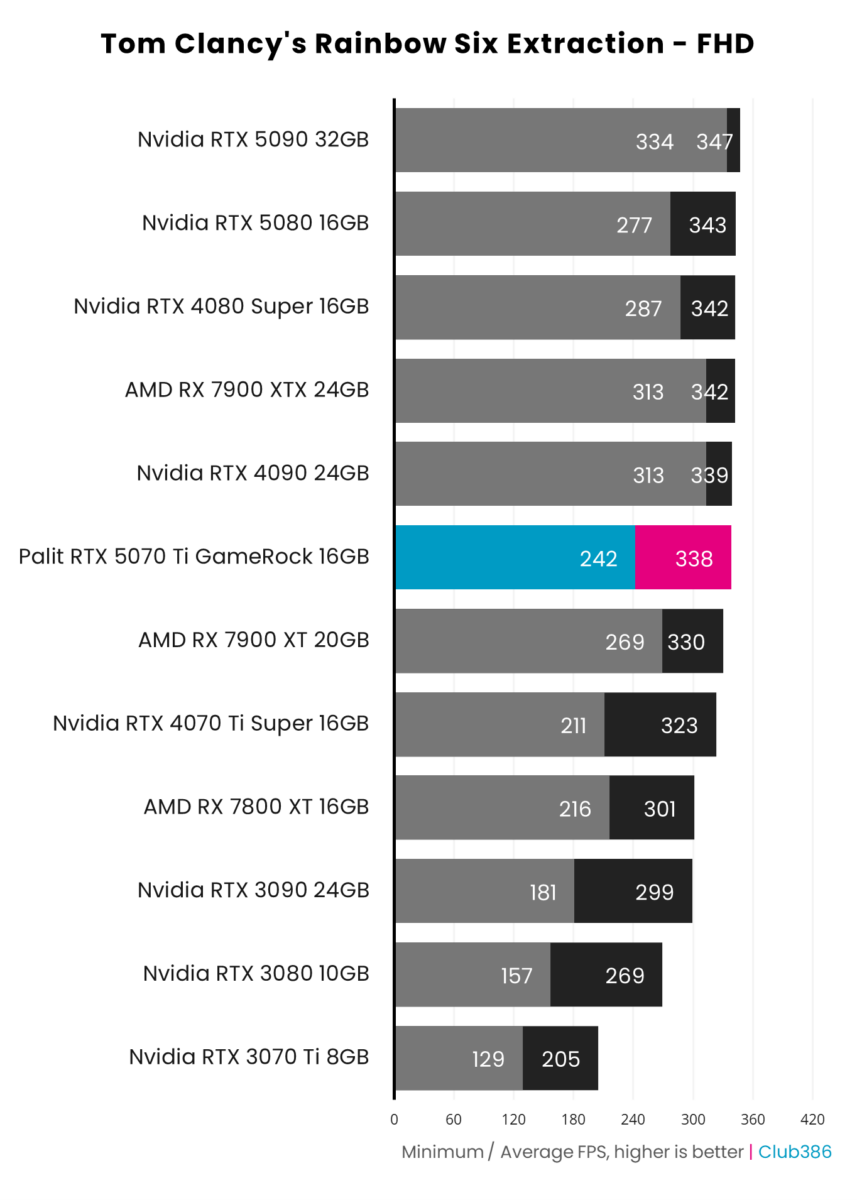
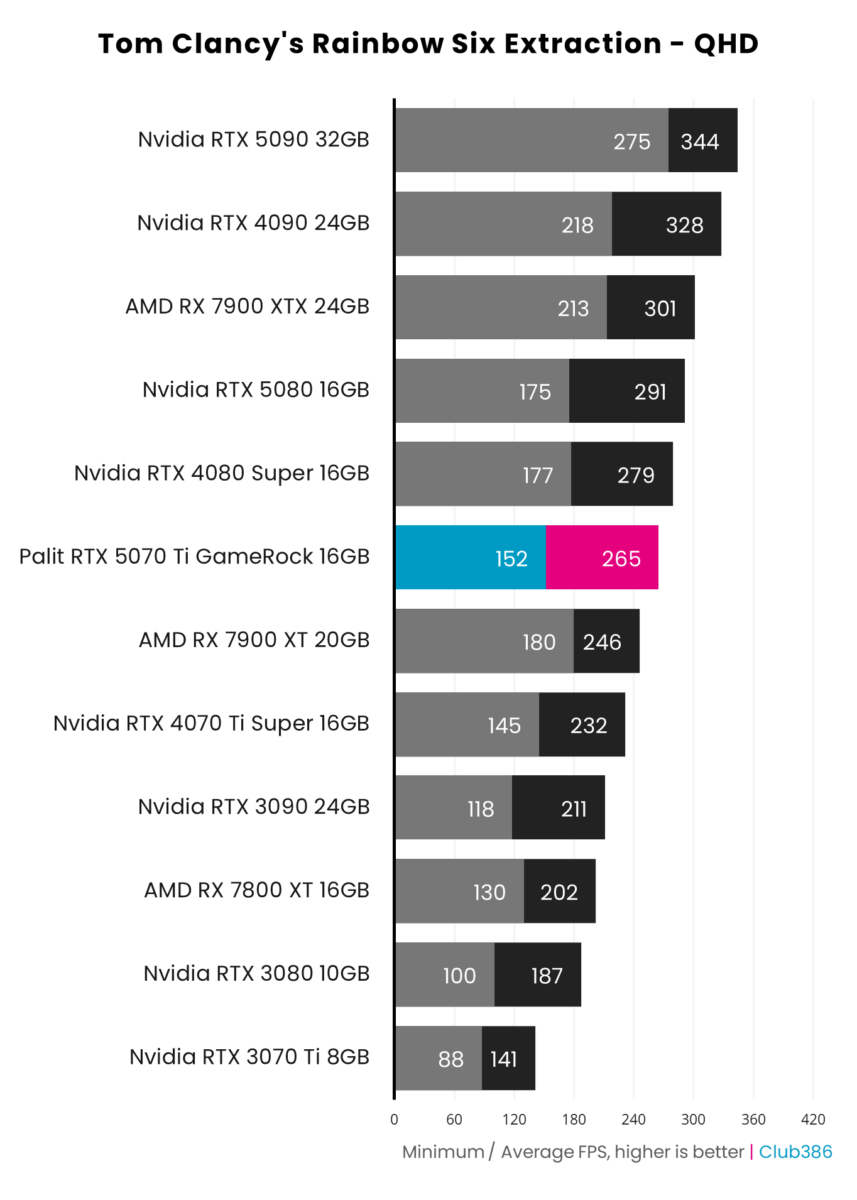
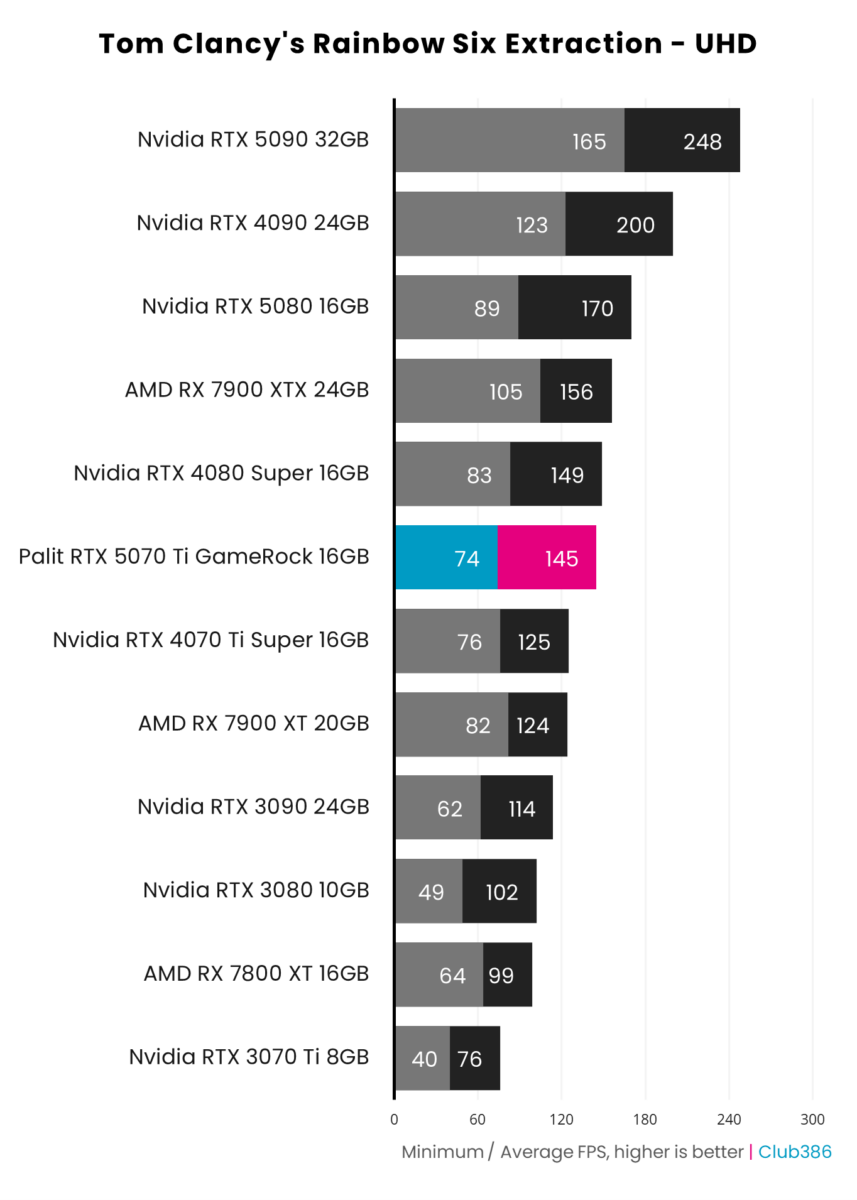
Ada Lovelace users won’t feel much pressure to upgrade looking at Tom Clancy’s Rainbow Six Extraction, with just 16% in it between the two x70 Ti cards at UHD. Instead, RTX 3070 Ti owners have plenty to gain with a potential 91% uplift thanks in large part to double its VRAM.
| Average increase or decrease at 4K | |
|---|---|
| RTX 5090 to RTX 5070 Ti | -42% |
| RTX 4090 to RTX 5070 Ti | -27% |
| RTX 5080 to RTX 5070 Ti | -14% |
| RTX 4080 Super to RTX 5070 Ti | -4% |
| RX 7900 XTX to RTX 5070 Ti | -1% |
| RX 7900 XT to RTX 5070 Ti | +15% |
| RTX 4070 Ti Super to RTX 5070 Ti | +17% |
| RTX 3090 to RTX 5070 Ti | +31% |
| RTX 3080 to RTX 5070 Ti | +52% |
| RX 7800 XT to RTX 5070 Ti | +58% |
| RTX 3070 Ti to RTX 5070 Ti | +112% |
Palit GeForce RTX 5070 Ti GameRock makes a good case as a UHD graphics card more than QHD, although it only becomes an enticing prospect if you’re rocking something a little older. Ampere and lower-tier Radeon users could find merit in the jump, although it’s worth remembering that Radeon RX 9070 XT looms on the horizon.
We’re not done just yet, though. Nvidia’s encore focuses on Multi Frame Generation (MFG), to which AMD has no retort just yet.
Frame Generation
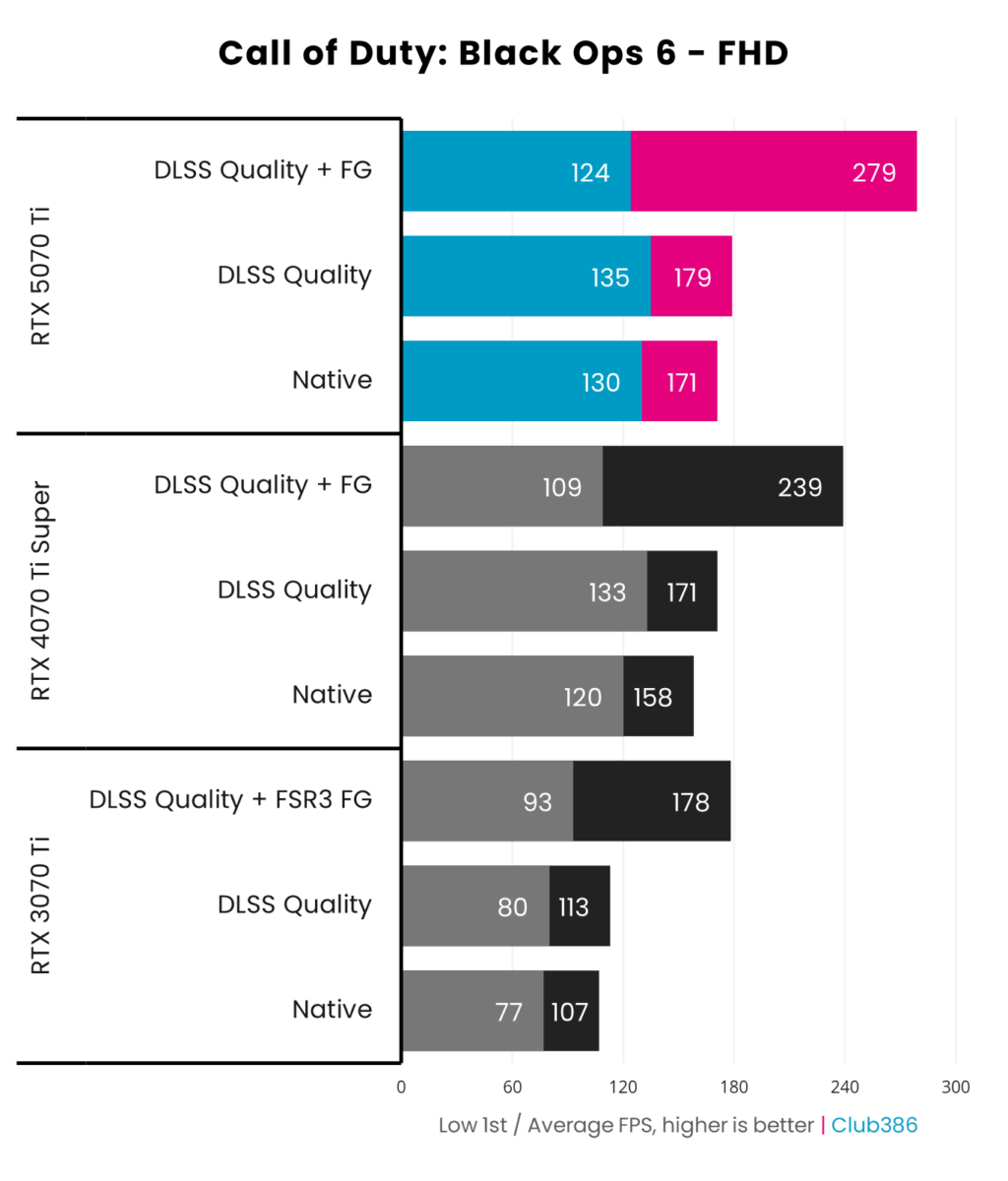
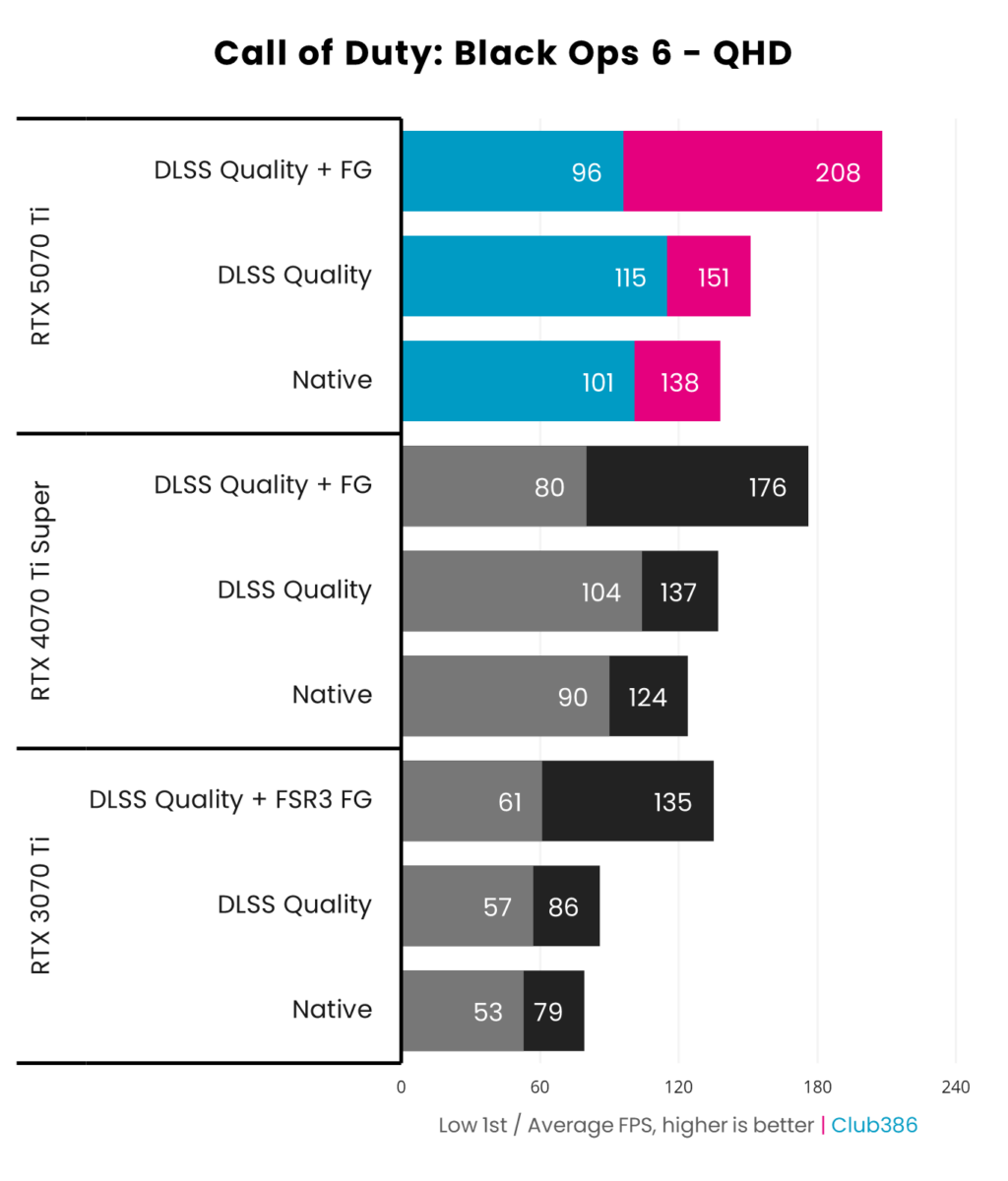
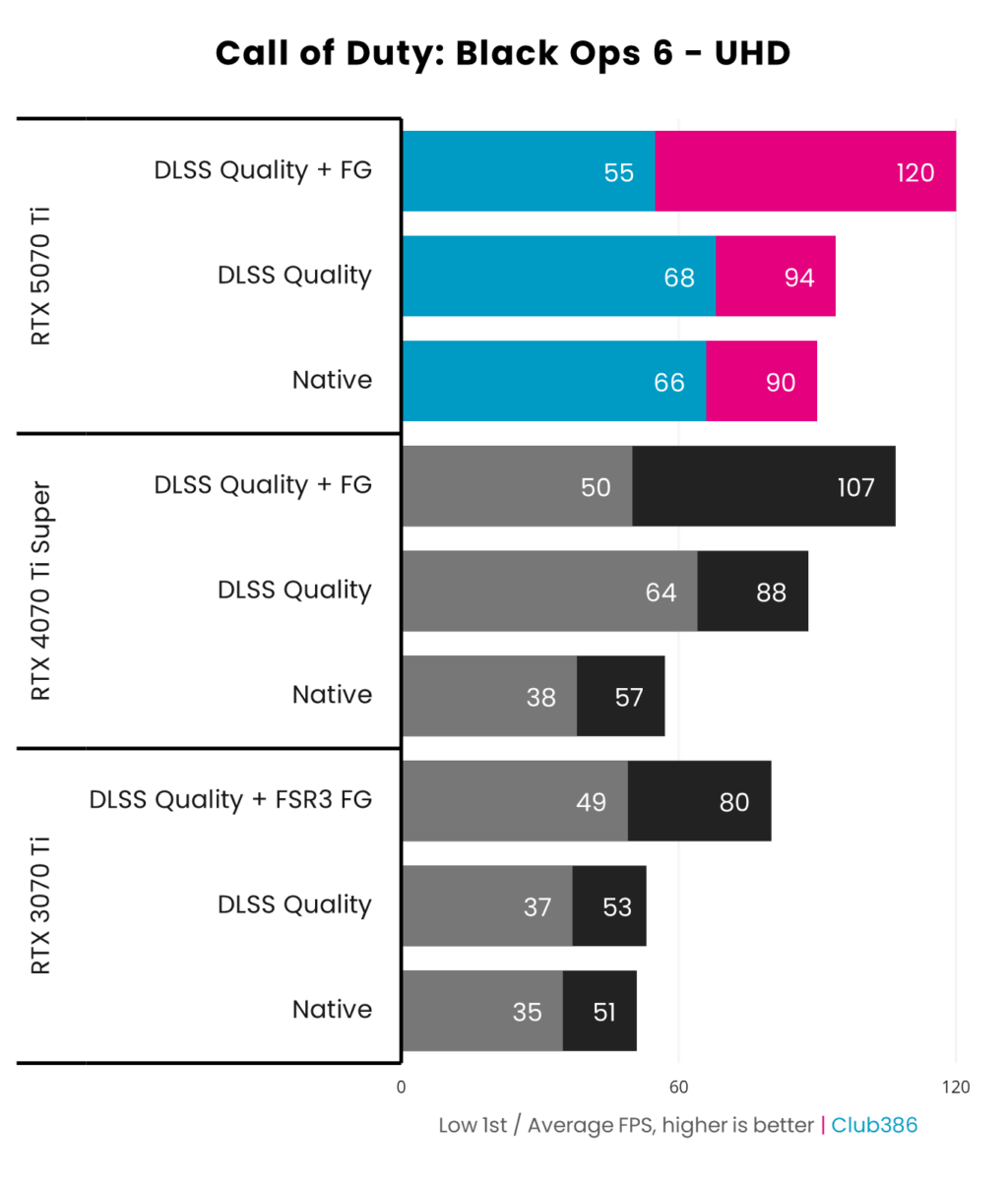
The native performance uplift is impressive with Palit’s RTX 5070 Ti pushing 58% higher than its predecessor at UHD. By comparison, sandwiching an extra AI-generated frame in between each rasterised one with Frame Generation sits in its shadow with a slim 12% difference, but that’s not the full story.
Pushing past that coveted native 60fps mark at 4K helps reduce latency when you use Frame Generation. Safe to say DLSS 4 treats the new architecture like royalty.
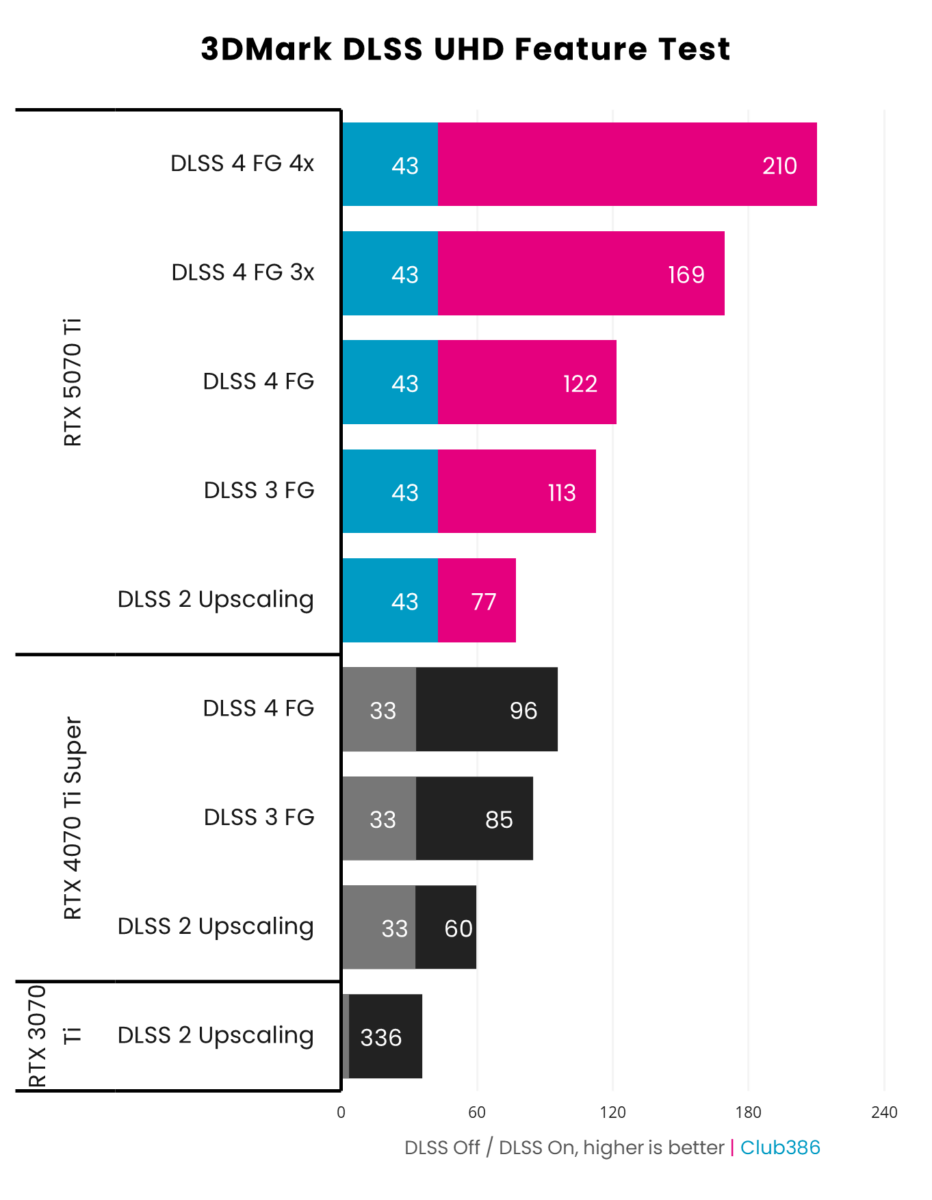
DLSS has come a long way, but it’s Blackwell that makes full use of its upscaling magic. With Nvidia’s Multi Frame Generation, you’ll see a second or third AI-generated frame enter the fray for every rasterised entry. This one-click option raises the performance ceiling two-fold, with Nvidia GeForce RTX 5070 Ti offering 210fps for every 96fps RTX 4070 Ti Super can produce.
The caveat here is that the tech requires developer implementation, which immediately reduces compatibility. Nvidia promised at least 75 games will support the feature with more to follow, but it’s worth checking your favourite titles before buying on the promise of doubling your frame rates.
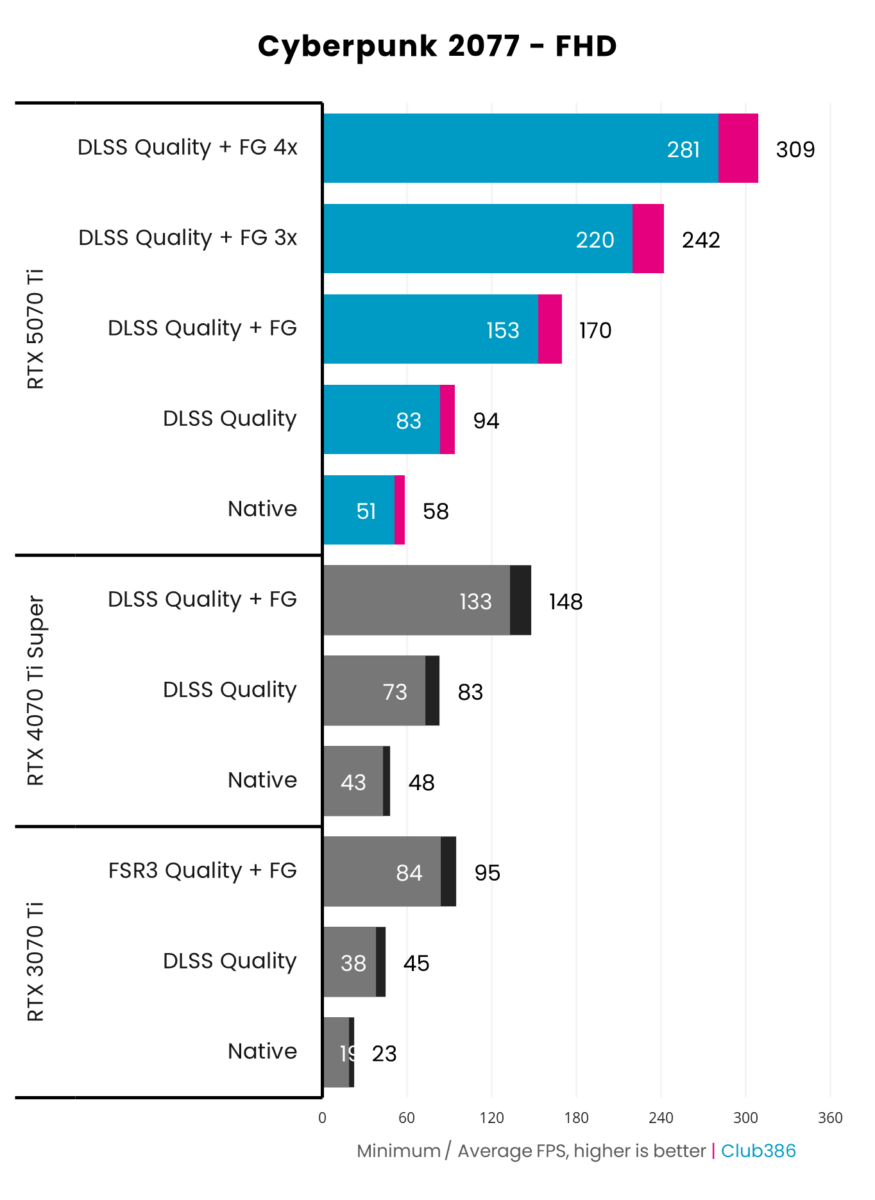
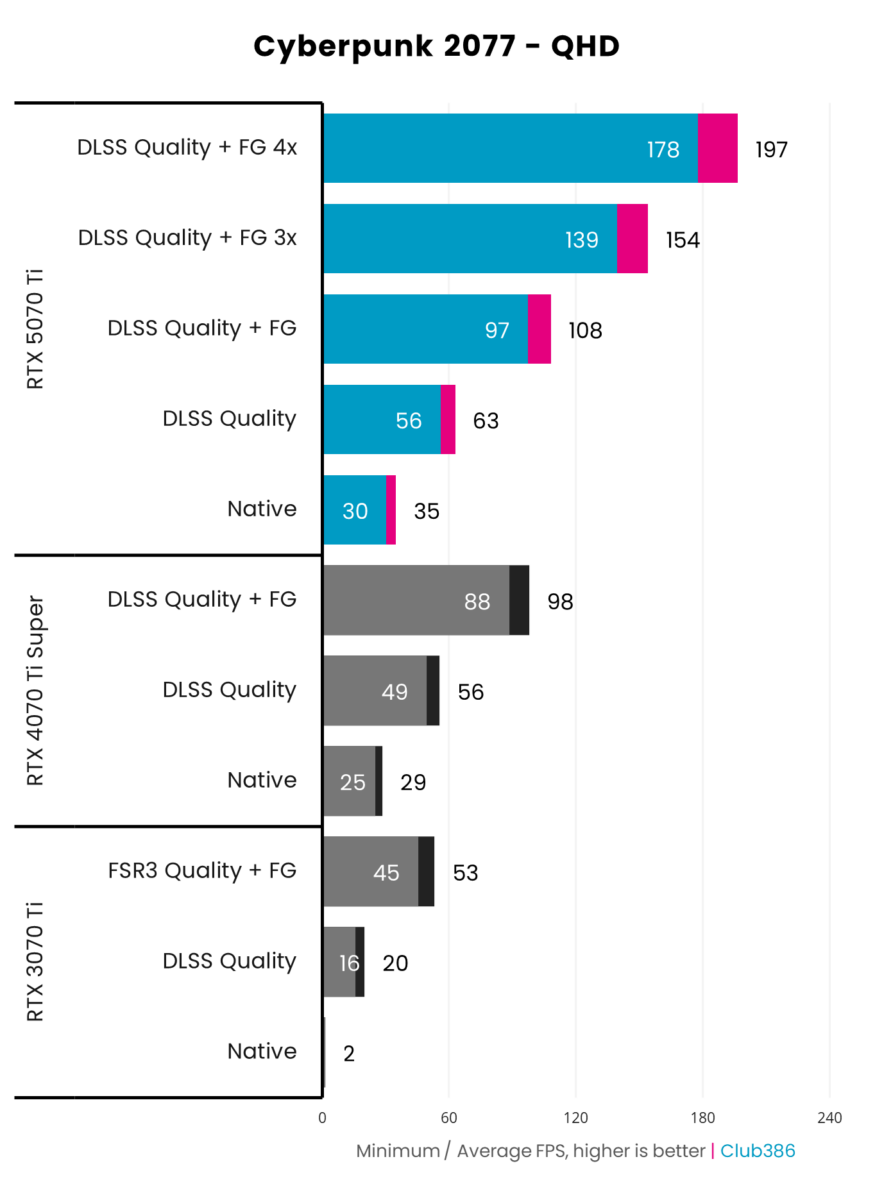
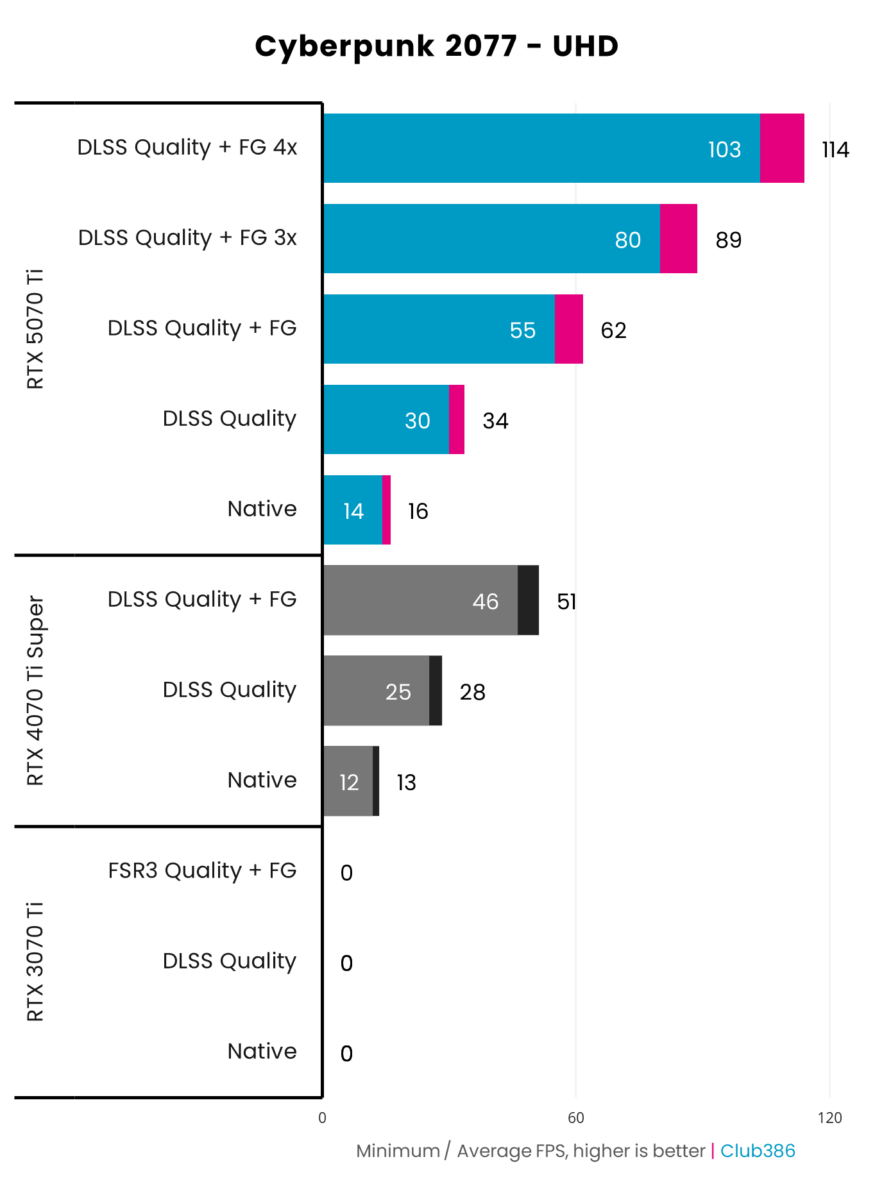
As you can tell by the poor, old RTX 3070 Ti’s inability to finish the benchmark at UHD, Cyberpunk 2077 is infamous for pushing GPUs to their limits with its monstrous path tracing preset. Even the RTX 4070 Ti Super, a former midrange powerhouse, struggles to keep up at UHD.
Enter the RTX 5070 Ti. It comes tantalisingly close to meeting the challenge with standard FG, but it’s Multi Frame Generation that truly elevates it to a class of its own. With MFG in full swing, you’ll hit triple-digit frame rates at any resolution, effectively doubling the standard Frame Generation’s capabilities.
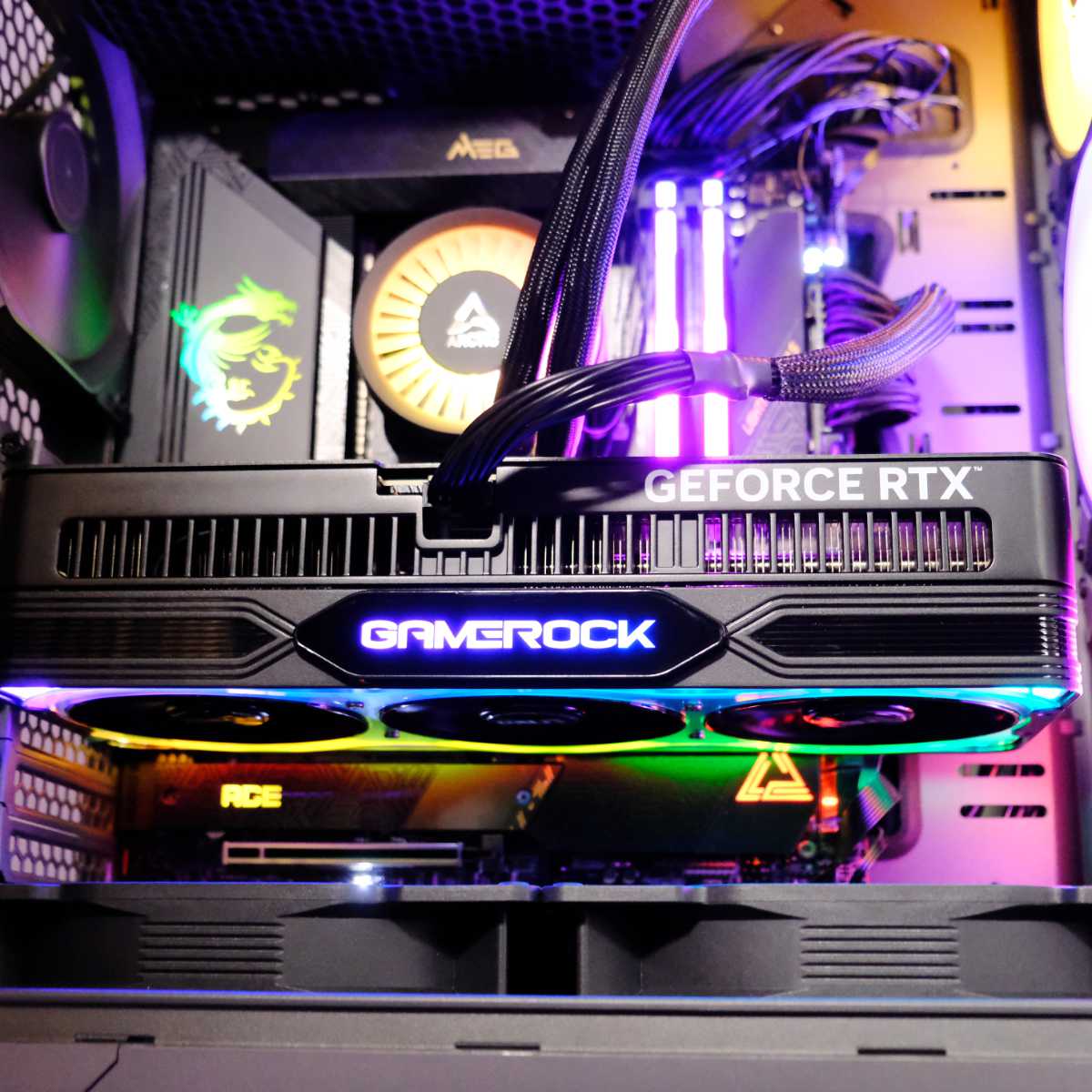
Conclusion
Palit GeForce RTX 5070 Ti GameRock mirrors many of the trends set by RTX 5080 and RTX 5090 before it. You can expect modest rasterised performance uplifts, particularly for RTX 40 Series owners, but there’s beauty in its Multi Frame Generation capabilities if support for the feature picks up. Neural rendering is the future, even if it’s early days.
Adding a £70 premium is a bold move given the difficulty of maintaining MSRP in the current climate, making price something of a concern. Thankfully, Palit’s exceptional cooling, whisper-quiet operation, and a respectable overclock all band together to spotlight its value. Plus, just look at that rockin’ bod.

